ONE DARING MISSION
Trojan researchers aim to help the nation achieve its Cancer Moonshot.




Trojan researchers aim to help the nation achieve its Cancer Moonshot.



Ever wondered what it feels like to float in space? USC Jimmy Iovine and Andre Young Academy student Anna Shaposhnik (foreground) has a pretty good idea. In May, she was invited to participate in the Aurelia Institute’s first zero-gravity research flight—the closest you can get to experiencing space on Earth.
 PHOTO BY STEVE BOXALL/ZERO GRAVITY CORPORATION
PHOTO BY STEVE BOXALL/ZERO GRAVITY CORPORATION
EDITOR-IN-CHIEF Ted B. Kissell CREATIVE DIRECTOR Jane Frey MANAGING EDITOR Lilledeshan Bose ASSOCIATE EDITOR Chinyere Amobi COPY EDITOR
The term “moonshot” has become a shorthand for collaborative efforts to achie ve some lo f ty go a l. But when we deploy the term here at USC, it c arr ies more weight. Af ter all, famed USC alumnus Neil Armstrong was once, in fact, shot to the moon.
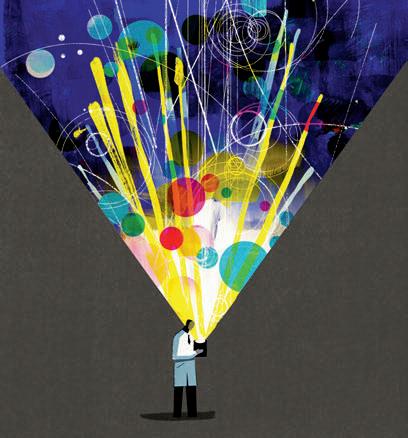
It’s only fi tt i ng th a t the f eder a l go vernment’s C ancer M oonshot, whi ch seeks to reduce the c a ncer de a th r a te by 50% w i th i n 25 ye a rs, would enl i st t a lented Tro ja ns whose expert i se w i ll help pow er the med i c a l equ iva lent o f the Apollo 11 m i ss i on.
When President Joe Biden announced the relaunch of the Cancer Moonshot in Febru a ry, USC c a ncer rese a rchers John C a rpten a nd Peter Kuhn were i n a ttendance. Along with faculty colleagues like He i nz-Jose f Lenz, C a rpten a nd Kuhn a re a nswer i ng Pres i dent B i den’s c a ll to “end c a ncer a s we know i t.”
USC’s connection to this nationwide effort dovetails with one of USC President Carol L. Folt’s own “moonshot” initiatives:
transforming and expanding USC’s health sciences. In the cover story of this issue of USC Trojan Family Magazine, you’ll le a rn how these c a ncer spec ia l i sts a re using cutting-edge treatments to fight the disease—while also addressing systemic inequities in the quality of c ancer c are.
You c a n a lso re ad a bout the Keck School of Medicine of USC’s groundbreaking street medicine residency program, as well as how the dedication of the new USC Arcadia Hospital is expanding access to Keck Medicine of USC’s worldclass c are. And our article detailing the pr ivacy problems with the Venmo app connects to another of President Folt’s moonshots: advanced computing.
To paraphrase our spacefaring alumnus, these small steps for Trojans will build toward a giant leap into a brighter future for the wider world.
Ted B. Kissell Editor-in-ChiefUSC Trojan Family Magazine
e., CAL 140 Los Angeles, CA 90089-2818 magazines@usc.edu | (213) 740-2684
USC Trojan Family Magazine (ISSN 8750-7927) is published in print twice a year by USC University Communications.
MOVING? NEW EMAIL? Update your preferences at trojanfamily.usc.edu/subscribe.
ADVERTISING: V isit trojanfamily.usc.edu/advertise for information.
The 88th annual Alumni Awards; meeting poets where they are; and a new USCAA Board of Governors president.
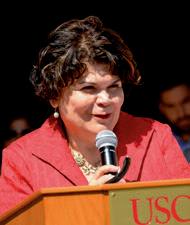
Onward
eet the man behind the Trojan sword and armor.

A USC Thornton School of Music collaboration brought the social and environmental disaster caused by the 1986 nuclear power plant explosion in Chernobyl, Ukraine, to the stage. All the Truths We Cannot See: A Chernobyl Story, a joint project with the University of the Arts Helsinki’s Sibelius Academy, made its U.S. premiere at USC’s Bing Theatre on April 11; the opera had its world premiere in Helsinki a month earlier.
During the winter, student cast members Krishna Raman, Madeleine Lew, Christine
If you watched this year’s Academy Awards, Grammys or NFL Draft, then Madigan Stehly ’14 helped light up your night. The USC School of Dramatic Arts alumnus has made a career as lighting director for everything from TV variety shows to some of entertainment’s biggest events, securing nine Emmy nominations and two wins—for 2016’s Grease Live! and 2019’s Rent: Live “I love the live event and variety special world,” he says. “It’s theater at a massive scale—moving lights, LEDs, an incredibly fast pace. As a lighting nerd and a theater nerd, it’s hard to watch something like So You Think You Can Dance or the Grammys and not geek out. … Those kinds of live events also require the collaborative nature and problem-solving process [of] theater, and that’s my favorite part.”


Stehly got the design bug while studying technical direction at USC. He volunteered to design lighting for school shows and worked as a lighting tech at USC venues, including an Elton John concert at Bovard Auditorium.
“To look back now, it’s wild,” Stehly says. “I’m so thankful. I know how lucky I am to be doing what I’m doing.”
Marie Li, Lily Smith and Lorenzo Zapata and opera program resident stage director Ken Cazan, who directs the production, traveled to Helsinki for several weeks of preparation. When Russia invaded Ukraine in late February, the preparation process took on greater importance.
“As living conduits of art, it’s our responsibility to tell the stories that instill change, that remind everyone of the past so that we can learn from our mistakes,” Zapata says. “It’s hard at times to inhabit a character’s pain who was once real, but in doing so, reminding others of the past’s suffering may keep it just there—in the past.”
The work’s references to environmental disasters, incompetent leaders, and human and environmental survival may
help audiences draw parallels between the days following the power plant accident and the present day, Cazan says: “It
Playing at the Hollywood Bowl would be a highlight for any performer, members of the Trojan Marching Band included.

What’s remarkable is that more than 90% of the band’s members don’t major in music and do not plan to pursue a career in the field, so a Hollywood Bowl appearance is all the more special.
“As a musician myself, I’ve never had the opportunity to play on the stage at the Hollywood Bowl,” band director Jacob Vogel says. “What’s exhilarating to me is to be able to provide these opportunities for the incredibly diverse student body within the band.”
This summer, the band’s four-decade tradition of Bowl play continued on Opening Night, as they shared the stage with headliner Gwen Stefani and, in what was billed as their “firstever joint performance,” the UCLA Marching Band. The two bands returned a week later for a “battle of the bands” at the 101 Festival. And later in the summer, the Trojans accompanied the Los Angeles Philharmonic for the annual Tchaikovsky Spectacular, performing the finale of the “1812 O verture.”
The band’s teaching assistant, Jeanine Guerrero, recalls that the Bowl was the furthest thing from her mind when she started out as clarinetist with the Spirit of Troy: “I thought I was just going to play for football.”






Maybe we can’t sol ve all the world’s environmental problems—but that doesn’t mean we c an’t try to be eco-minimalists. J ill Sohm, associate professor of environmental studies and director of the environmental studies program at USC Dornsife College of Letters, Arts and Sciences, says eco-minimalism is “focused on reducing environmental impact by simplify ing your life and buy ing less.” USC experts offer five ways to help you join the movement.
SMALL STEPS, TOGETHER
Eco-minimalism comes down to consuming less: “Lots of people making small changes all together can have a large impact,” Sohm says. “Making sustainable choices is empowering in a world where it can feel like we don’t have much control.”



“Wanting something


Animal products are water- and energyintensive to produce, says Audra Isadora Bardsley, a lecturer in USC Dornsife’s environmental studies program. “We actually dedicate more land in the U.S. to growing food to feed animals than we do food to feed people.”


delivered to your door quickly raises your footprint,” Vos says. “If items are delivered by airplane versus container ship, their impact on the environment is higher.”




Vos recommends using home appliances rated as Energy Star, which use less energy and meet strict energy-efficiency criteria from the EPA and U.S. Department of Energy.


In the United States, nearly 30% of greenhouse gas emissions in 2019 came from transportation, according to an Environmental Protection Agency report. To mitigate it, drive less, suggests Robert Vos, associate professor and director of graduate studies at USC Dornsife’s Spatial Sciences Institute. Instead, walk, bike or use public transit.




As fellow Trojans, we believe that our time at USC served as a launch pad for success. Allow our team of wealth advisors to help you explore ways to transition your success into a legacy. L O S A N G E L E S | S A N D I E G O | B A T O N R O U G E O E S E O R
Let’s talk, Trojan to Trojan Contact us today.
 Securities offered through Hightower Securities, LLC member FINRA/SIPC. Hightower Advisors, LLC is a SEC registered investment advisor.
Securities offered through Hightower Securities, LLC member FINRA/SIPC. Hightower Advisors, LLC is a SEC registered investment advisor.
Football player Brenden Rice ’24 wears the Catapult system during practice. The harness carries a device that monitors each athlete’s training data to optimize their performance.

Trojan trailblazers reflect on how far the quest for women’s equality has come and where it still needs to go.
When Title IX—the landmark legislation that prohibits sex discrimination in educational institutions that receive federal funding—was signed into law in 1972, it had an immediate impact at USC. Here, we celebrate the progress USC has made and the women who’ve helped pave the way for gender equity in all aspects of USC’s programming, from education to employment and extracurricular opportunities.
“I am thrilled about the fact that I was there in the very beginning. … I was in charge of the women’s athletics program, and I knew that USC needed to be a leader in providing opportunity for women in athletics.
“Women w a nted to h av e a progr a m comparable to the men. … At that time, many athletic directors were fighting T itle IX; [athletic director John McK ay] didn’t do that. He agreed to go to the university, and the university said yes. And the rest is history. USC mo ved a he ad wh i le m a ny schools were j ust st ay i ng i n pl ace.”
—BARBARA HEDGES, ATHLETICS ADMINISTRATOR WHO HELPED IMPLEMENT TITLE IX AT USC IN 1973

“What T itle IX has been able to do is crea te these br av e sp a ces where people c a n come for support and education and also for mediation, for awareness and for justice. … Knowing that T itle IX exists along with policies that are enforced is definitely important in order to be confident and move forward.”
—ANNALISA ENRILE, CLINICAL PROFESSOR, USC SUZANNE SCHOOL OF SOCIAL WORK“Women, especially women of color, need all the help we can get from legal statutes that basically help us to just get through the door. Because once we get through the door, we can perform. ”
“We need to be sens i t ive to the fact th a t T i tle IX, though i t m ay ne ver be repe a led, c a n be so eroded a nd ch a llenged by the courts th a t i t m ay not be a s i t i s tod ay. Our challenge is to fight, to uphold the principles and application, and never let it be ignored.”
—YVONNE BRATHWAITE BURKE, FORMER U.S. REPRESENTATIVE AND FORMER MEMBER, USC BOARD OF TRUSTEES


USC’S VICE PRESIDENT FOR STATE GOVERNMENT RELATIONS AND SPECIAL COUNSEL, ON

USC Annenberg and Paramount establish first-of-its-kind scholarship advancing Latino diversity in newsrooms.
America’s newsrooms do not reflect the populations they ser ve: While the nation’s Latino population is expected to rise to 119 million or 29% of the total U.S. population by 2060, they currently make up a mere 7.8% of the TV news workforce and 6.5% o f TV news d i rectors a t non-Sp a n i sh-language stations.
Seeking to increase the number of Latino journalists in the news industry, the USC
Annenberg School for Communication and Journalism and Paramount are investing in the graduate education of Latino students.
The Pa r a mount L a t i nx D ivers i ty i n Journ a l i sm Schol a rsh i p, supported by a $1 million gift, will cover yearly tuition costs for a Latino student to enroll in one of USC Annenberg’s journalism master’s programs.
The new Pa r a mount L a t i nx schol a rs w i ll f urther bolster the a pprox i m a tely
20% o f USC Annenberg’s gr adu a te j ourn a l i sm students who i dent if y a s L a t i no or H i sp a n i c. These students, supported by USC Annenberg faculty, h ave cre a ted new i n i t ia t iv es such a s the student-run media brand c alled Dímelo, which aims to re ach young L a t i no a nd H i sp a n i c adults w i th stor i es a nd content exper i ences i n Sp a n i sh a nd Engl i sh.
“We know the education, training and connections students build in our programs equip them for successful journalism careers,” USC Annenberg Dean Willow Bay says. “This scholarship offers an invaluable opportunity for Latinx journalists to bring those skills to America’s newsrooms, which need their talent and expertise to reach their audiences now more than ever.”
USC study finds long COVID affects 23% of positive cases, causing symptoms that may last months.
Headaches. Fatigue. Diarrhea. If you experienced any of these symptoms weeks af ter you tested negative for COVID19, you m i ght be a “long h a uler.” A new USC study finds that 23% of people infected with COVID develop the sometimes debilitating symptoms that can last for months.
“Long COVID i s a m aj or publ i c he a lth concern. Twenty-three percent i s a very h i gh pre va lence, a nd i t m ay translate to millions of people,” says first a uthor Q iao Wu, a doctor a l c a nd i d a te a t the USC Leon a rd D avi s School o f Gerontology. “ M ore knowledge on i ts pre va lence, pers i stent symptoms a nd r i sk factors m ay help he a lth c a re pro f ess i on a ls a lloc a te resources a nd ser vi ces to help long h a ulers get b ack to norm a l l ives.”
SARS-CoV-2 is typically an acute illness lasting about three weeks, but the World Health Organization and USC researchers define long COVID as symptoms that last 12 weeks or longer.
Using the Understanding Coronavirus in America survey conducted for the study
by the USC Center for Economic and Social Research at the USC Dornsife College of Letters, Arts and Sciences, USC researchers interviewed 308 infected individuals culled from 8,000 participants.

After accounting for preexisting symptoms, about 23% of the participants reported that they had exper ienced new-onset symptoms during infection which lasted for more than 12 weeks, meeting the study’s definition of long COVID.
The new-onset, persistent symptoms most commonly exper ienced by long COVID patients were headache, runny or stuffy nose, abdominal discomfort, fatigue and diarrhea
In addition, the researchers found th a t people h a d s i gn ifi c a ntly h i gher odds of experiencing long COVID if, at the time of infection, they were obese, experienced hair loss, or had a headache or a sore throat.
There was a lack of evidence relating the risk of long COVID to preexisting health conditions, such as diabetes or asthma, or age, gender, race/ethnicity, educ ation or current smoking status.
LEIGH HOPPERResearchers from USC Dornsife developed a public database that gives insight into fatal encounters with the police.
Researchers from the USC Dornsife Center for Economic and Social Research (CESR) are seeking answers and have developed the publicly accessible National Officer-Involved Homicide Database (NOIHD) to help give fresh insight regarding fatal encounters with police.

“Most research regarding police homicides is based on data aggregated from a state or county,” says Brian Finch, a researcher who led the development of the database. “We built the NOIHD to better understand the factors that may be related to deadly police incidents … at a more micro level.”
His team pulled from the U.S. Census, the American Community Survey, the FBI’s Uniform Crime Reports and other sources to create the database.
Finch, a professor of sociology and spatial sciences at the USC Dornsife College of Letters, Arts and Sciences, says some preliminary findings, which have not yet undergone peer review, were unsurprising. “For example, departments that require officers to have more training and higher levels of education tend to have lower levels of homicide,” he says.
What was surprising to Finch is that officerinvolved homicides seem to be increasing faster in suburban and rural areas than in cities. His research also indicates that deadly incidents with the police are less likely to show up in official sources if the medical examiner or coroner is overseen by the sheriff’s department rather than by another county department. JIM KEY
Medicine program has dropped precipitously since 2018, from over 30% to 7%.
For Sayre, the fact that a rotation in Street Medicine is a requirement made the Keck School stand out. “No other residency program is doing anything like this,” he says. “That really intrigued me.”
The activities of the Street Medicine program regularly extend beyond medical care. Team members may travel as far afield as assisting patients with housing aid, obtaining personal identification or finding transportation.
“Whatever we’re called to do in that moment on behalf of the patient, that’s what gets done,” Brett says.
Putting the patient so elementally at the center of health services is a lesson in itself. In Brett’s view, caring for a patient in Street Medicine means really caring.
When USC launched the Street Medicine program in 2018, it galvanized a cadre of Trojans—from doctors to nurses to residents and volunteers—to care for unhoused Angelenos.
By providing free, direct care on the streets and under bridges to the tens of thousands of people experiencing homelessness in Los Angeles, the program aims to address health inequities in the community.

“The people we serve have largely been excluded and forgotten by society,” says Brett Feldman, clinical assistant professor of family medicine and director of Street Medicine in the Keck School of Medicine of USC. “We feel strongly that they shouldn’t get less care.”
This year, the Keck School of Medicine doubled down on that mission with a new residency program in the Department of Family Medicine that requires first-year trainees to work with the Street Medicine team.
The new three-year Street Medicine track within the Family Medicine residency is the
first of its kind nationwide. Trainees gain firsthand experience in an extraordinarily patient-centered approach to care, according to Corinne Feldman, clinical assistant professor of family medicine and director of the Street Medicine track.
That mission resonates deeply with participants such as Matt Sayre, a medical doctor. “This residency gives me an opportunity to serve the underserved,” Sayre says. “That’s all I ever wanted to do. That’s why I went into medicine to begin with.”
“As medical students, our residents may have been taught that maintaining distance is a matter of professionalism, to avoid clouding their clinical judgment,” he says. “I hope the lesson they’re learning with us is the importance of loving your patients, and that’s OK. It means a lot that a school such as USC is building love and solidarity into its medical curriculum.”
—BRETT FELDMANThe Street Medicine program has had a substantial, measurable impact. Today, nearly three-quarters of unsheltered patients from Los Angeles County+USC Medical Center have seen a primary care provider through USC Street Medicine, up from little more than a quarter. At LAC+USC, the readmission rate for patients seen through the Street
Indeed, the first interns to enter the program see the opportunities for growth in bringing care to those who typically lack access, as part of a team accustomed to stretching scant resources.
“Family medicine calls us to treat everything under the sun, essentially,” Sayre says. “I’m learning a translational practice in that sense. In a resource-poor setting, with me and a backpack, how can I deliver the best possible health care?” WAYNE
LEWIS“We feel strongly that they shouldn’t get less care.”
USC headed to Big Ten Conference in 2024.
After being a stal wart of the Pac-12 Conference—or some version of it—for roughly a century, USC Athletics will have a new home in the Big Ten Conference starting in 2024. The move will position Trojan student-athletes to compete at the highest level on the field and in the classroom.


“This move to the Big Ten Conference positions all of our teams for long-term success,” says USC head football coach Lincoln Riley. “It provides our student-athletes with more exposure, new resources and challenges them with elite competition—USC Football is excited to compete in the Big Ten.”
The Trojans, along with crosstown rival UCLA, have become the latest examples of conference realignment in college athletics, with the announcement coming nearly one year after the University of Texas at Austin and University of Oklahoma announced they’d be leaving the Big 12 for the Southeastern Conference (SEC) in 2025.
The last expansion for the Big Ten came in 2014 when the conference added
the University of Maryland and Rutgers University. With the Trojans and the Bruins set to join the Big Ten on Aug. 2, 2024— enabling both schools to remain in the Pac-12 Conference for the duration of the Pac-12’ s existing media rights agreements—the conference officially becomes bicoastal.


“We look forward to competing these next two years in the Pac-12 and want to express our sincerest gratitude to the conference and its member institutions for decades of wonderful experiences,” says USC athletic director Mike Bohn. “The Trojans’ outstanding athletics heritage will always be synonymous with the Pac-12, and there are so many iconic moments and memories we will cherish forever—we hold the Pac-12 and our respected colleagues in the highest regard.”
Beginning the 2022-23 academic year, all USC student-athletes, regardless of scholarship status, will be eligible to receive up to $5,980 annually in direct financial support in the form of Alston academic achievement awards. This stems from last year’s U.S.
Supreme Court ruling that the NCAA can’t limit the education-related benefits offered to athletes by schools.
In 2021, USC posted its highest-ever NCAA graduation success rate: 92%.
“One of our priorities was to build a student-centric athletics program deeply committed to ensuring that all our student-athletes can compete at the highest level athletically and achieve at the highest level academically,” says USC President Carol L. Folt.
USC has more than 550 student-athletes who compete in 21 sports, supported by more than 250 coaches and staff. Trojan teams have won 134 national championships, and men and women have taken home 483 individual NCAA titles. The USC football program has won 11 national championships, competed in 34 Rose Bowls—winning 25—and produced 519 NFL draft picks. USC athletes also have won 326 Summer Olympics medals, 153 of them gold.
“Our move to the Big Ten positions USC for long-term success and stability amid the rapidly changing sports media and collegiate athletic landscapes,” Folt says. “Equally important, we are joining a conference that shares our values of academic excellence, athletic competitiveness and diversity and inclusion across all sports.”
GRAYSON SCHMIDTNoted USC faculty members Eileen Crimmins and Manuel Pastor have been elected to the American Academy of Arts and Sciences.
They join more than 250 accomplished individuals in this year’s academy class, which includes celebrated authors Sandra Cisneros and Salman Rushdie, former Brookings Institution president and retired U.S. general John R. Allen, Indigenous Canadian-American singer-songwriter Buffy Sainte-Marie, and multi-award-winning actor Glenn Close.
Founded in 1780, the academy convenes leaders from every field of human endeavor to examine new ideas and address pressing national and global issues.
Crimmins, a USC University Professor and the AARP Professor of Gerontology at the USC Leonard Davis School of Gerontology, is the only USC faculty member to be selected for membership to the American Academy of Arts and Sciences, the National Academy of Sciences and the National Academy of Medicine. A demographer, Crimmins says of joining the Academy, “I am particularly excited to engage with people who approach improving the quality of our lives from so many different directions.”
Pastor, who holds the Turpanjian Chair in Civil Society and Social Change and is director of the Equity Research Institute at the USC Dornsife College of Letters, Arts and Sciences, is an award-winning, nationally recognized scholar. He studies issues surrounding the economic, environmental and social conditions that low-income urban communities face as well as the social movements that aim to address and improve those conditions.
Study finds we overlook the influence of habits—like drinking coffee.

Did you drink a cup of coffee this morning? If so, was it because you actually felt tired, or did you simply follow a habitual morning routine?
A USC study published last spring in Psychological Science found participants underestimated the role of habit in their behaviors—including their coffee consumption.
“People may consume coffee out of habit—for example, you may automatically follow a coffee drinking routine when you wake up or go on your morning commute, regardless of how tired you are,” says study co-author Asaf Mazar, a doctoral candidate in psychology at the USC Dornsife College of Letters, Arts and Sciences.

That automatic triggering of behavior, versus conscious intentions, is what makes a behavior a habit, Mazar explains.
“Much of what we do every day is habitual, but we are reluctant to acknowledge our habits and instead chalk our behaviors up to our mood and our intentions,” says Wendy Wood, USC Provost Professor of Psychology and Business and co-author of the study.
To investigate just how much people underestimate the influence of habits, Mazar and Wood asked study participants what drives their coffee consumption. The respondents said fatigue was about twice as important as habit in prompting their coffee drinking.



Then, the researchers tracked the participants over the course of one week, recording their coffee drinking and tiredness every two hours. In contrast to the participants’ explanations, “we found that the participants strongly overestimated the effect of tiredness on their
coffee consumption and underestimated the effect of habit,” says Mazar.














The authors say that the gap between the actual and perceived role of habits in our lives explains why Americans have such a hard time changing ongoing, repeated behaviors—such as maintaining a steady exercise program and a healthy diet.
Some of this is cultural, they add. When asked to list what stops them from making beneficial lifestyle changes, Americans commonly cite a lack of willpower.
“To effectively change behavior, Americans must acknowledge that much of our behavior is habitual and automatic,” says Mazar. “Habits can keep us repeating unwanted behaviors, but they can also keep us on track in maintaining desirable ones, like working out or recycling.”
Wood and Mazar point to climate change as an example of a problem where people across the world are highly motivated to change their behavior to live more sustainable lives.
However, “they just don’t know what to do and how to do it repeatedly,” says Wood.





To better understand one piece of the sustainability puzzle, Wood and Mazar recently conducted a survey on recycling behaviors.
“Successful recyclers had figured out how to create habits—without having to stress or think much—that made recycling easy and rewarding,” explains Wood. “They put their recycling bins in the kitchen, not in the garage. They displayed signs indicating where to put the trash and how to sort it. They had these hacks.”
It may sound obvious, says Wood, “but it’s not what you know; it’s what you do.”
JENESSE MILLER














The applied analytics minor at the Information Technology Program is the most popular minor at USC.








Applied analytics probably isn’t the first subject that comes to mind when thinking of popular minors at USC. But with 550 Trojans currently minoring in applied analytics in the Information Technology Program (ITP) at the USC Viterbi School of Engineering, it is the university’s most popular minor. Cinema comes in second, followed by business finance, health care studies and business.
Students in the program can learn software programs, including SQL, Python and Tableau, as well as other tools to collect, clean and analyze data. Instruction in applied technology includes practical, hands-on experience, so they can leverage those insights to create data visualizations and dashboards.
“The applied analytics minor started four years ago when we realized that data analytics is something everybody needs to know,” says former program director Jeffrey Miller.
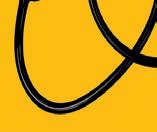

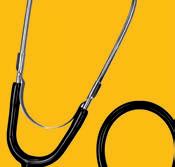
Jennah Motani ’24 decided to minor in applied analytics at the behest of her family, who said it would give her more career options and professional freedom. The business major says the tools she has acquired through ITP have equipped her to succeed as an associate consultant at Bain & Co., where she plans to work after graduation.
“Applied analytics taught me how to parse through huge amounts of data and figure out what’s important,” says Motani, co-president of the Trojan Consulting Group. “These are skills I need as a consultant.”


Founded in 1981, ITP has grown exponentially. As more USC students, especially nonengineers, have sought to broaden their technological abilities, the number of ITP courses and minors has similarly surged.
A decade ago, ITP offered 35 classes and five minors. Today, there are 93 courses and 17 minors. In 2011, 729 students took ITP courses; today, that number has more than tripled to 2,600, Miller says.
“We have students who get internships after taking two classes with us and afterward become computer programmers or data analysts,” he adds. MARC BALLON

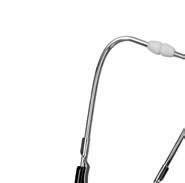









Dance scholar Julia M. Ritter is named new USC Kaufman dean.
Award-winning dance artist and scholar Julia M. Ritter was named dean of the USC Kaufman School of Dance in July.

Before joining USC, Ritter was a professor of dance at the Mason Gross School of the Arts at Rutgers University, where she served as chair and artistic director of the department of dance from 2010 to 2021.
Throughout her career, she has worked at the intersection of the arts, humanities and sciences to engage with social justice and community building. Her 2021 book, Tandem Dances: Choreographing Immersive Performance, examines the role of dance in the emerging field of immersive theater and performance.
Founded in 2012, USC Kaufman is known for its innovative New Movement educational model, which combines rigorous dance training with interdisciplinary studies and cross-campus collaboration.
“I am so excited to join USC Kaufman because of what has already been established here, including the stellar faculty and students, the Glorya Kaufman International Dance Center and the New Movement curriculum,” Ritter says. “There is an incredible amount of innovation happening across USC right now, and there are no limits to how we can ideate and collaborate.”
TED B. KISSELLSuzanne Nora Johnson ’79, an internationally recognized leader who has served at the highest levels of major nonprofit and corporate organizations, was elected chair of the USC Board of Trustees in June.
John Iino ’87, a respected attorney and champion of diversity, equity and inclusion issues, was also elected to the Board.
Nora Johnson is the former vice chair of the Goldman Sachs Group, where she served as chair of the Global Markets Institute and was a member of the firm’s management committee.
She currently serves as board chair and chair of the compensation committee for Intuit Inc. and is chair of the audit committee at Pfizer Inc. She also serves on the boards of the Broad Foundation, the Brookings Institution (co-chair), America’s Frontier Fund and the Markle Foundation (chair).


During her more than two decades on the USC Board of Trustees, Nora Johnson has been an advocate for transformational leadership at the institution.
“Leadership is a team sport, and I believe our work as a board and as a university will be strengthened by engagement with USC students, faculty and staff as well as members of the broader Los Angeles community,” she says. “As chair, I will be dedicated to unifying the Trojan Family to accomplish the ambitious goals set by President Carol L. Folt.”
Nora Johnson earned her bachelor’s degree from USC in interdisciplinary studies with emphases in economics, philosophy, religion and political science in 1979, and received her JD from Harvard Law School.
Iino, who recently completed a two-year term as president of the USC Alumni Association, is global chief diversity officer with the law firm Reed Smith, an international practice with more than 3,000 employees around the world. He earned his law degree at the USC Gould School of Law and was the first Asian American Gould alumnus on the school’s Board of Councilors.
He led the USC Alumni Association through two years marked by the pandemic and the ongoing recovery, and is especially proud of the diverse volunteer leadership team that helmed the Alumni Association during his presidency.
As he joins the Board of Trustees, Iino keeps Trojan values foremost in his mind.“There’s a mantra we say: ‘Trojans help Trojans.’ I really try to live that,” he says. “I’m very excited. I really believe that the future is bright.”
DAVID MEDZERIANIn recognition of the many steps USC has taken to care for the LGBTQ+ community, Keck Medicine of USC hospitals and USC Student Health, part of Keck Medicine, received the designation of “LGBTQ+ Healthcare Equality Leader” in the Human Rights Campaign Foundation’s Healthcare Equality Index (HEI).

HEI surveys health care facilities on policies and practices dedicated to the equitable treatment and inclusion of LGBTQ+ patients, visitors and employees. This is the sixth time in recent years that Keck Medicine hospitals have received this distinction, which recognizes the numerous initiatives to support LGBTQ+ patient-centered care.
The Keck Medicine Gender Affirming Care Program provides transgender, nonbinary and gender-diverse patients access to comprehensive, affirming health care. The Keck Pride committee helps design and implement strategies to foster a welcoming environment for LGBTQ+ patients, families and employees. The health system also offers various training opportunities around LGBTQ+ health.
USC Student Health, which offers comprehensive health care to USC students, participated in the survey for the first time and is one of a select group of college health care providers to receive the leader designation.
“My journey has been rocky, but I knew that education would be the thing that would take me out of that previous lifestyle,” Waters says. “When I got accepted to USC, I was like, ‘This is going to be what gets me out of poverty.’”
Griffin hopes to stay in the Bay Area, work in a substance abuse program and eventually be in a position to have an impact on people’s lives.
Susan Hess, a faculty adviser to Unchained Scholars, explains that the women’s lived experience has fueled their passions around transformative practices to promote community healing. It’s part of what unites everyone within Unchained Scholars, which has about a dozen members.
By the time they arrived as master’s degree students at the USC Suzanne Dworak-Peck School of Social Work in fall 2020, both Tangela “Tangie” Griffin and Myra Waters already knew how to handle adversity.
Growing up in the Bay Area, Griffin saw poverty and drug use from an early age, and her own drug use led to her incarceration. Waters grew up in South Los Angeles, where her first brush with jail came at 18 years old. She’d spend the next six years in and out of jail for a variety of offenses, including theft and prostitution, but at age 24 she decided to make a change.

“A conviction is something that happened to you, but it doesn’t define all of you,” Waters says.
She went on to earn her bachelor’s degree in sociology from California State University, Los Angeles, while Griffin earned her bachelor’s in sociology and urban planning from San Francisco State University. After gaining admission to USC, both women originally worried that they wouldn’t fit in—until they heard about Unchained Scholars.

Started in 2018, Unchained Scholars is a group of formerly incarcerated master’s and doctoral social work students that works to dismantle the barriers faced by people affected by the criminal punishment system. Griffin and Waters joined the group as soon as they arrived on campus. In 2021, after the organization’s then-president Evan Moore passed away, Waters took on the role of president of Unchained Scholars, while Griffin became the vice president.

Now, Waters hopes to use her experience and education to assist those within South L.A. who are in the same position she was in. Waters is interning with Alcott Center for Mental Health Services, an L.A.-based nonprofit that provides therapy, case and medication management, crisis intervention, trauma-informed studio art classes, and supportive housing for people navigating mental health challenges or justice-involved reintegration.
And both Griffin and Waters see how the group can expand its reach. Whether helping students pay for caps and gowns for graduation or expanding their membership to include students who were in group-home settings or foster care, Unchained Scholars ultimately aims to help more students understand that their pasts do not define them.
“Unchained Scholars has been very effective in creating a platform for students who were affected by the judicial system at all levels,” Griffin says. “There’s a sense of kinship here.”
GRAYSON SCHMIDTUSC Michelson Center opens three new facilities in a cross-campus collaborative space.
The opening of three cutting-edge facilities at the USC Michelson Center for Convergent Bioscience brings together researchers from the university’s engineering and medical schools and the USC Dornsife College of Letters, Arts and Sciences.

The three state-of-the-art research facilities—the Core Center of Excellence in Nano Imaging, the John O’Brien Nanofabrication Laboratory and the Dynamic Imaging Science Center—held a grand opening in May, where attendees were given tours of such highlights as the transmission electron microscope inside the Core Center of Excellence in Nano Imaging.
Professor Andrea Armani of the USC Viterbi School of Engineering, director of the John O’Brien Nanofabrication Laboratory, says the event was the celebration of an accomplishment that had been in the works for more than a decade. It is named after the USC Viterbi executive vice dean who passed away in 2017.
“It’s always important to celebrate a very long-haul victory,” Armani says. “We started conceptualizing the facility in 2009, but it didn’t start to become a reality until an anonymous naming gift in 2017 allowed it to be programmed into the Michelson Center. Because of COVID-19, we haven’t had a chance to get
together and celebrate the facility’s opening, which has truly been a catalyst for all the undergrads, graduate students and postdoctoral researchers across USC.”
The USC Michelson Center brings together a diverse network of scientists and engineers from USC Viterbi, Keck School of Medicine of USC and USC Dornsife College of Letters, Arts and Sciences. It provides a multidisciplinary environment to solve problems such as cancer, neurological disease and cardiovascular disease. GREG HERNANDEZ
kinds of skills the School of Dramatic Arts and School of Cinematic Arts have to offer.
USC’s Communication and Journalism, Dramatic Arts and Cinematic Arts schools join forces to help budding storytellers master podcasting.
Murder mysteries. SCOTUS decisions.
Haitian history. Music from the ’90s. Name a subject, and there’s likely a podcast for it.

The storytelling format has grown in popularity in the past two decades; in 2021, there were an estimated 120 million podcast listeners in the United States, with forecasts suggesting that number will surpass 160 million by 2023.

To help students learn more about using this rising storytelling platform, the USC Annenberg School for
Communication and Journalism, the USC School of Dramatic Arts and the USC School of Cinematic Arts collaborated to create a podcasting minor in fall 2021.
According to USC Annenberg Dean Willow Bay, streaming service Spotify has been working with USC and other top-tier universities to encourage and inspire students to enter podcasting as well as help them get training, mentorship and professional development. “They [Spotify] need talent to power this growth,” Bay says.
USC Annenberg already had audio reporting and podcasting classes, but podcasting companies are also looking for the

Designed to give students a grounding in the history, theory, production and business of podcasting, the podcasting minor teaches journalism skills—narrative, fact-checking and writing—as well as performance aspects.
“Dramatic Arts helps students develop as effective and engaging performers who connect to the podcast audience through voice acting,” says Emily Roxworthy, dean of the School of Dramatic Arts. “I hope that students learn how to leverage podcasting as a mode of expression that is both creative and political.”
“In other words,” Roxworthy adds, “it has enormous power in our highly mediated world, but only by learning to be effective storytellers and polished performers will they truly harness this power to create successful podcasts of their own.”
GRAYSON SCHMIDT




We provide world-class health care built on possibility. We don't shy away from the tough cases. We help our patients achieve their greatest potential.




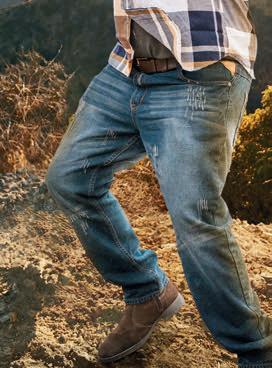

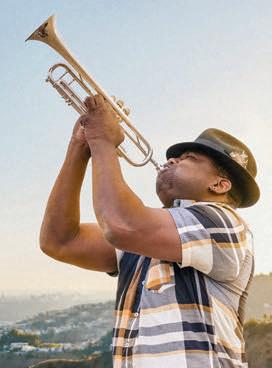
ACHIEVE ITS CANCER MOONSHOT.
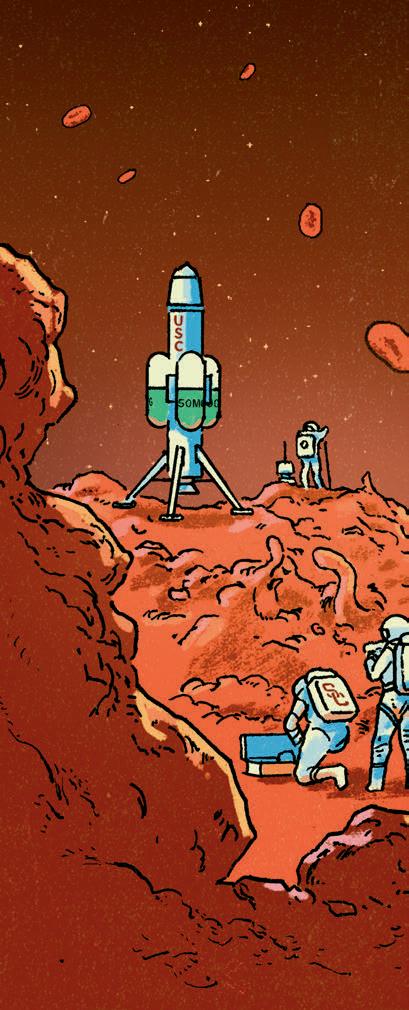 BY DANIEL P. SMITH ILLUSTRATIONS BY CURT MERLO
BY DANIEL P. SMITH ILLUSTRATIONS BY CURT MERLO
Victor Perez didn’t think much about his weight loss. He had noticed some other changes, too. In the interest of being proactive, Perez, 38, of Long Beach, Calif., went to his primary care doctor.
His physician recommended a colonoscopy. “To be safe,” he told Perez.
On Nov. 15, 2021, the day before his daughter’s sixth birthday, Perez learned he had colon cancer. A subsequent CT scan showed the cancer had spread to his liver. Stage 4.
“It felt like a death sentence,” says Perez’s wife, Joanne, who survived her own battle with Hodgkin lymphoma as a teen.
Perez enrolled in a clinical trial with a novel drug combination at the USC Norris Comprehensive Cancer Center and began experimental chemotherapy treatments under the care of Heinz-Josef Lenz, J. Terrence Lanni Chair in Gastrointestinal Cancer Research and professor of medicine and preventive medicine. His first visit lasted 14 hours, taxing his body and his soul.
But, Perez says, “I knew it was giving me a chance to live.”
Every other week since, Perez has endured two consecutive days of chemo. He sees others: young and old, men and women, cutting across ethnic and socioeconomic lines, in worse shape than he is, clinging to life—and hope. Each trip awakens his humanity and intensifies his prayers for remedies.
“I don’t want to see people suffering,” Perez says. “I want there to be treatments that help people live.”
It is a hope that millions of cancer patients around the globe share. It’s also a hope that USC is well-positioned to fulfill as a research institution and health care provider.
Earlier this year, two leading cancer researchers from the Keck School of Medicine of USC stood by President Joe Biden as he announced an ambitious national effort to slice the cancer death rate in half within 25 years. USC’s


connection to what the White House has called the Cancer Moonshot is just one of the ways the university and the Keck School of Medicine are leading the charge to improve cancer treatment by addressing medical inequities in research, developing new approaches for deadly and rare cancers, supporting patients and caregivers, and learning more from people living with cancer.
Cancer has long been a target of some of the world’s sharpest scientific minds, including researchers at USC, as well as health care organizations, nonprofit entities and public agencies such as the National Institutes of Health, the Centers for Disease Control and Prevention and the National Cancer Institute.
At his final State of the Union address in January 2016, then-U.S. President Barack Obama unveiled a Cancer Moonshot program explicitly crafted to accelerate the rate of progress against cancer—a decade of progress in five years, the president beamed. To lead the ambitious program, Obama turned to Vice President Joe Biden, who had recently lost his 46-year-old son, Beau, to brain cancer.
Later that year, Congress overcame its partisan divide and passed the 21st Century Cures Act. The legislation devoted $1.8 billion to provide seven years of new funding for cancer research. It also created the Oncology Center of Excellence at the U.S. Food and Drug Administration to streamline the review of promising treatments.
The earliest years of the Cancer Moonshot initiative marshaled the vast resources of the federal government, a critical component in such an immense scientific battle, and delivered enticing progress. There were important developments in treatments and diagnosis, including encouraging clinical trials and successful public health education campaigns that propelled screenings and early detection. There were also heightened efforts to reduce cancer disparities and critical advancements in sharing data, such as the Cancer Research Data Commons.
Meanwhile, new researchers poured into the field, driving breakthroughs in genomics, genome editing and diagnostics.
Cancer, one of humanity’s foremost universal enemies, was under siege in new and profound ways.
The COVID-19 pandemic, however, thwarted the momentum, interrupting cancer research and patient care for two years. Many patients skipped routine cancer screenings such as colonoscopies and mammograms. Research programs slowed amid mandated shutdowns. Outreach efforts, such as health fairs, workshops and recruitment for clinical trials, languished.
On Feb. 2, 2022, now-President Biden stood in the White House and announced a reignited commitment to the Cancer Moonshot, and he did so with a new, ambitious goal: to reduce the death rate from cancer by at least 50% in the next 25 years.
With a “fierce sense of urgency,” Biden pledged a vigorous fight against cancer and better support for cancer patients and their families.
“We can do this. For all those we lost, for all those we miss. We can end cancer as we know it,” he said.
The American Cancer Society reports that about 1.9 million Americans receive a cancer diagnosis annually, and about
600,000 die of the disease each year. Biden’s headline-grabbing announcement—a monumental, galvanizing gesture from the White House—restored a national bull’s-eye on cancer.
Capitalizing on progress in research and patient-driven care as well as the scientific advances and public health lessons of the COVID-19 pandemic, the White House stressed a renewed, reinvigorated focus on cancer prevention, detection, diagnosis and treatment for all U.S. residents.
It was a call to arms transcending politics and an invitation to a daring scientific crusade.
In the White House that day, alongside cancer patients and government leaders, scientific disruptors and health care industry representatives, USC cancer researchers John
—PRESIDENT JOE BIDENCarpten and Peter Kuhn listened to Biden’s every word, inspired and hopeful that the president’s message would rally the nation in a way the space race had six decades ago.
“This is a conversation that touches everyone,” says Kuhn, the Dean’s Professor of Biological Sciences at the USC Dornsife College of Letters, Arts and Sciences. “It sets a mission for the nation and identifies cancer as something we need to do something about.”
Carpten and Kuhn’s presence at the Cancer Moonshot’s White House relaunch was a testament to their track records as combatants against cancer.
Carpten, who is the chair of the Biden administration’s National Cancer Advisory Board, directs the Institute of Translational Genomics at the Keck School of Medicine and is also the associate director of basic science for the USC Norris Comprehensive Cancer Center, one of the nation’s most innovative forces in cancer treatment, research, prevention and education.
An internationally recognized leader in cancer genomics, precision oncology and cancer disparities, Carpten studies DNA and RNA sequences of tumors using next-generation instrumentation. A prolific researcher, he has been the principal investigator or project lead on nearly two dozen National Cancer Institute grants over the last 15 years.
Carpten, Lenz and Mariana Stern, the Ira Goodman Chair in Cancer Research and associate director for population sciences at USC Norris, oversee the ambitious project along with David Wesley Craig, professor and vice chair of the Department of Translational Genomics within the Keck School of Medicine. Together with other USC scientists and patient participants, they will be studying colorectal cancer in Hispanic patients such as Victor Perez. The study is supported by a five-year, $18.5 million grant from the National Cancer Institute, part of the Cancer Moonshot initiative.
"FOR ALL THOSE WE LOST, FOR ALL THOSE WE MISS. WE CAN END CANCER AS WE KNOW IT."
Understanding how certain diseases and treatments affect underrepresented racial and ethnic groups is crucial to saving lives, Carpten says. “We have not done enough to understand how to engage with patients and communities to reveal the barriers and concerns and to create approaches that are sensitive and culturally appropriate.”
With about 500 Hispanic males, among the largest-ever cohorts of Hispanics in a clinical trial, Lenz— who leads the study—says they are addressing the
knowledge gap on the molecular composition of colon cancer in Hispanics, who have the highest increase in early-onset colon cancer. Conducted with scientists from various disciplines at the center, researchers hope to drive a more comprehensive characterization of colon cancer in this population and spur improved diagnostic methods and therapeutic options.
“We’re taking advantage of our county’s patient population and learning from them,” Lenz adds. “It’s showing how cancer research isn’t done in an ivory tower at Norris, but we can learn from our patients.”

Meanwhile, Kuhn, a cancer physicist who runs the Convergent Science Institute in Cancer at the USC Michelson Center for Convergent Bioscience, has directed cancer-battling research programs marrying physics and mathematics. With a particular focus on improving cancer diagnostics, treatments and access, the programs include spearheading the creation of the world’s first liquid biopsy database on cancer. Liquid biopsies represent a noninvasive way to help predict how a cancer will behave in the body, enabling doctors to spot cancers earlier and better determine treatment options. The liquid biopsies also promote increased access to care because it’s easier for most American residents to get blood drawn.
“We need a tool to support decision making and that isn’t necessarily cutting someone open and looking for it,” Kuhn says. “With these liquid biopsies, we’re finding and characterizing cancer with a blood draw.”
Kuhn’s ATOM-HP project, developed in collaboration with Jorge Nieva, associate professor of clinical medicine at the Keck School of Medicine, is providing doctors with real-time patient data from wearable technologies. Even if the patient is remote, physicians can access a comprehensive, data-driven and timely view of the individual’s health to inform treatment plans.
"WE’RE TAKING ADVANTAGE OF OUR COUNTY’S PATIENT POPULATION AND LEARNING FROM THEM."
—HEINZ-JOSEF LENZ

USC’s fight against cancer extends far beyond Carpten and Kuhn, involving researchers across the university leveraging community partnerships, institutional infrastructure and USC’s built-in equity with patients. Investigators are pursuing bold, innovative work, analyzing novel ideas and developing auspicious strategies for diagnosis and treatment.
Bodour Salhia, associate professor for translational genomics at the Keck School of Medicine and co-leader of the cancer center’s Genomic and Epigenomic Regulation Program, is spearheading projects on liquid biopsies for breast and colon cancer and plays a critical role in the Moonshot grant.
Alan Wayne, associate director for pediatric oncology at the USC Norris cancer center and professor of pediatrics at the medical school, is working on next-generation immunotherapies to treat pediatric blood cancers while also exploring treatments that help the body’s own immune system fight the cancer attacking it.
Lenz and Steve Kay, University and Provost Professor of Neurology, Biomedical Engineering and Biological Sciences at the medical school, are leading a drug develop-
“Our secret power at USC is that we function as a community,” says Kuhn, adding that USC researchers are not only receptive to interdisciplinary work but intentionally prioritize such collaboration. “The Trojan family concept gives us agility, and our work is universally aligned to improving patient outcomes.”
Additionally, USC’s robust infrastructure provides researchers critical access to cutting-edge resources that empower them to probe intriguing questions and generate new knowledge. The USC Norris cancer center, for instance, is a global leader in molecular characterization and is well-known for personalized clinical trials.
“The Norris cancer center has significant strength dealing with diverse patient populations, and this gives us incredible insights into treatments, outcomes, efficacy and interventions,” Lenz says.
Finally, USC boasts one of the most diverse patient populations in the United States and, even more, thoughtfully designed outreach programs to broaden patient representation.
“USC Norris cancer center is a national leader in research to reduce cancer disparities,” says Caryn Lerman, USC Norris Comprehensive Cancer Center director and the H. Leslie and Elaine S. Hoffman Chair in Cancer Research. “Our innovative community outreach and engagement programs will benefit greatly from the discoveries emerging from USC’s Cancer Moonshot program.”
—PETER KUHNment project targeting molecules in circadian pathways that regulate humans’ sleep-wake cycles, an inventive approach that turns the body’s circadian rhythm against cancer.
And in May, Preet Chaudhary, Bloom Family Chair in Lymphoma Research, professor of medicine and director of the Blood and Marrow Transplant and Cell Therapy Program at the cancer center, received a $5.8 million grant from the California Institute for Regenerative Medicine to develop next-generation cell therapy for prostate cancer.
“We need continuous scientific inquiry and continuous scientific breakthroughs. That’s what will lead the way,” Kuhn says.
Among the nation’s major research universities, USC is particularly well-situated to lead the battle against cancer.
The university hosts active and energized research programs driven by inquiry, rooted in purpose and fostering accessibility and equity. There are, for instance, research efforts studying prostate cancer in African Americans and breast cancer in Hispanics.
Many research projects, meanwhile, crisscross schools and colleges in the USC ecosystem and feature basic scientists working alongside clinical scientists. At the USC Michelson Center, researchers from biology, medicine, engineering, computer science, chemistry and even the humanities collaborate on projects devoted to improving the lives of those who have cancer.
Partnerships with industry, pharma, health care companies and L.A.’s swelling biotech scene further strengthen USC’s ability to fuel productive cancer research. USC and Cedars-Sinai Medical Center received the U.S. Department of Defense’s first Virtual Cancer Center Director Award in 2021 to launch the Convergent Science Virtual Cancer Center. Experts at the center will advise emerging scholars from diverse research backgrounds and institutions in pursuing scientific advancements in cancer.
“We are well-positioned to be collaborators of the highest level and are aligned to have impact,” says Keck School of Medicine Dean Carolyn Meltzer.
In fact, Meltzer promises more ambitious research, more interdisciplinary collaboration within USC and with external partners, more diversity in trials and genetic testing, deeper community engagement to enroll more patients in clinical and translational research and continued investments in infrastructure to propel the university’s ambitious efforts.
To Meltzer’s point, the Keck School of Medicine and the USC Norris cancer center recently teamed with Children’s Hospital Los Angeles to open a Current Good Manufacturing Practice (cGMP) facility at the cancer center. The new facility will enable scientists from various disciplines to collaborate on the study, development, manufacturing and testing of cell-based treatments for a range of diseases and disorders.
“We want to grow a critical mass of cancer researchers and really challenge ourselves because if we don’t challenge ourselves, we won’t succeed,” Meltzer says. “We’re prepared to think bigger and bolder because we know that’s what beating cancer demands.”
And it is what patients like Victor Perez need.
"OUR SECRET POWER AT USC IS THAT WE FUNCTION AS A COMMUNITY."
Deeper: To find out more about John Carpten and Peter Kuhn, read their full profiles on trojanfamily.usc.edu.
Peter Kuhn possesses an unrelenting drive to improve the lives of cancer patients.
BY DANIEL P. SMITHPeter Kuhn is an unlikely force in the battle against cancer. A physicist who dreamed of designing cars at Porsche, the German native came to the United States not for academic enrichment, but for a dream inspired by the 1986 film Top Gun
“I saw that movie and knew I needed to ride motorcycles in Southern California,” he says.
But when Kuhn was 17, his mother was diagnosed with breast cancer. That life-shaking event triggered his curiosity about the role physics—Kuhn’s chosen field of study—plays in the human body, such as the evolution and ecology of cancer cells.
Kuhn moved to the U.S. to pursue his graduate studies in physics. He joined the faculty at Stanford University, before the Scripps Research Institute in La Jolla, Calif., wooed him to establish a physics oncology program in 2002. It was Kuhn’s first foray into cancer research, and it captivated him.
In 2014, Kuhn left Scripps to become a founding member of USC’s new Michelson Center for Convergent Bioscience, a 190,000-square-foot interdisciplinary research facility committed to exploring new frontiers in medicine and health.
“USC is the only place that allowed me to focus my science on improving patient outcomes, to work with as many colleagues
as necessary across all the disciplines of the university for the sole purpose of making progress toward a better tomorrow,” Kuhn says. “If you want to use science to beat cancer, then this is what it takes: being able to pull expertise and resources across the entire university with agility and flexibility to discover new science and bring it to the patients in a meaningful way.”
Donors think so, too. Kuhn’s CSI-Cancer lab was made possible by a gift from Carol Vassiliadis, a cancer survivor who lost her husband to colon cancer in 2002.
During the last eight years, Kuhn has established himself as one of the world’s foremost experts on personalized medicine and individualized cancer patient care.
He co-directed the creation of the first global liquid biopsy database on cancer and helped develop groundbreaking, tech-fueled efforts injecting objectivity and measurable data into physicians’ performance status assessments. His work has advanced the understanding of cancer’s movement through the body and unlocked new possibilities for expanded access to care and personalized care strategies.
Throughout it all, he maintains an unrelenting focus on improving the lives of cancer patients. “If not that, then what are we doing here?” Kuhn asks.
John Carpten is on a mission to find how genes influence cancer—especially for groups hit hardest by the disease.
BY WAYNE LEWISIn 2010, John Carpten was discussing the treatment for a breast cancer patient with a team of oncology experts using the complete genetic sequence taken from the patient’s tumor: the first case within a genomic study he led.
Carpten remembers hanging up the phone and saying, “Now I know why I was born.” After more than two decades of working on human genetics and disease, his research was directly impacting health treatment.
Now the professor and founding chair of translational genomics at the Keck School of Medicine of USC, founding director of the USC Institute of Translational Genomics and the holder of USC’s Royce and Mary Trotter Chair in Cancer Research, Carpten often talks about his life’s purpose.
Carpten grew up in the Mississippi Delta, and his family cultivated his passion for science. His interest in genetic engineering deepened at the Ohio State University, where he focused on molecular genetics and cellular and developmental biology. Even then, he knew he had opportunities that few young African American men had in 1988. “We were just jumping into this genetic revolution ... to help us understand more about human diseases,” he says.
When Carpten moved on to work at the National Human Genome Research Institute, he not only focused on life-changing cancer treatment through
genomics; he also developed an interest in understanding why cancer hits Black people and other people of color harder.
It became his mission to untangle the role of biology in cancer to improve treatment— particularly to help close the gaps where Black people and other understudied, underserved populations face a greater burden of disease and worse outcomes from cancer than whites.

“It was the beginning of my understanding that my gifts were meant to serve a purpose: to help my community,” he says.
Today, Carpten’s concentration on health disparities shapes the diseases he studies, including prostate cancer, breast cancer, multiple myeloma and cholangiocarcinoma, an aggressive cancer of the liver bile ducts.
In 2016, Carpten brought his lab to USC. Diversity in Los Angeles played a big factor in his move: “I couldn’t pass up the opportunity to apply these medical innovations in a way that patients from all walks of life could access.”
Carpten’s work and success—resulting in President Joe Biden appointing him to chair the National Cancer Advisory Board—is ultimately “not about me,” he says. “It’s about a national agenda for cancer research and care. For me, that agenda is reducing the overall mortality rates and closing the gaps where there are differences.”

A team led by USC Viterbi researchers has discovered millions of “ privacy leaks ” on the mobile social payments app.
BY MARC BALLON • ILLUSTRATION BY JOSH COCHRANThe bizarre request came from her husband at 2 a.m.
In May 2021, Keighley Woodard’s out-of-town spouse asked her to send him $195 on the Venmo payment app. He included an electronic note simply saying that he would explain later.
The hour of the request, coupled with her husband’s strange message, raised her suspicions.
What Woodard didn’t know is that several of her husband’s friends received the same request at nearly the same time. According to WSMV News4 in Nashville, Tenn., his friends assumed he had some sort of emergency and transferred money from their Venmo accounts to his.
The problem? They had unwittingly given money to a hacker who had cloned their friend’s Venmo account, complete with his real picture and name.
The popular payment app makes user profiles, payment notes and friend lists public by default so anyone can see your information. Journalists have used the app’s search function to uncover President Joe Biden’s Venmo account and his network of associates—including other high-ranking officials. Researchers have found explicit messages between lovers and drug dealers.
And bad actors have repeatedly harvested information from unwitting users and created fake profiles of Venmo customers, sometimes just by adding a hyphen or an underscore to their names, to request money. It’s widespread enough that the Better Business Bureau warned users of the scam in August 2021: “Using the information visible in Venmo’s public feed, they figure out from whom this person had previously sent or received money. Then, scammers contact these users with requests for money.”
Although Venmo allows users to make their transactions private, experts say many don’t have the technological wherewithal or presence of mind to change their settings. By making so much information publicly available, Venmo inadvertently puts users at risk. “People [on Venmo] share addresses that can be misused [through] identity theft. Someone could even come and rob you or stalk you,” says Jelena Mirkovic, research associate professor at the USC Viterbi School of Engineering and a project leader at the USC Information Sciences Institute.
“If you share something sensitive, like ‘Here’s money for drugs or drinks’ or ‘It was a great party in Vegas,’ that can have implications later on. For instance, it could affect your job prospects,” adds Mirkovic, co-author of “I Know What You Did on Venmo: Discovering Privacy Leaks in Mobile Social Payments,” an academic paper recently published in the Privacy Enhancing Technologies
addresses, phone numbers, and even Wi-Fi, bank account and Netflix passwords. By default, Venmo makes it all public.
In a contemporaneous study, Mirkovic, Tandon and their colleagues identified members of Alcoholics Anonymous, biker gangs and gamblers through their Venmo friend networks—even though many people in these groups went to extraordinary lengths to hide those affiliations by sending nonsensical messages with their Venmo payments.
“The notes of other users and sometimes the group’s display name on Venmo expose the sensitive nature of everyone’s membership,” Tandon says.
In other words, what happens on Venmo doesn’t necessarily stay on Venmo.
In 2009, Iqram Magdon-Ismail and Andrew Kortina, students at the University of Pennsylvania, came up with the idea for Venmo: a platform that would allow friends to send money to one another.
The pair initially set up Venmo as a private and textbased platform restricted to BlackBerry devices. Soon after, they decided to make payments publicly visible, although not the amounts. “I was thinking in the back of my head, ‘What if we made a feed for everybody?’” Magdon-Ismail told Wired in March 2017. “This kind of is like Facebook or Twitter for me.”
The company has grown considerably since PayPal acquired it in 2013—it now has 83 million users—but one aspect hasn’t changed: the money app’s strong social orientation.
Unlike competing payment apps, “Venmo provides a social way to pay your friends when you owe them money and don’t want to deal with cash,” the company says on its website.
Most Venmo accounts have a “friends list” that shares transaction details in social media-like feeds, including payment notes. Last year, Venmo made it possible for users to make their list of friends private.
The app’s social functions have won it legions of fans. Still, critics contend that malefactors have repeatedly abused Venmo to violate people’s privacy, accessing publicly available information to steal from and harass unsuspecting users.
Symposium. Taken even further, victims of domestic abuse might have their whereabouts and activities unmasked whenever they exchange payments and messages with friends.
In the biggest quantitative study of its kind, Mirkovic and a team of researchers—including USC Viterbi PhD students Rajat Tandon and Pithayuth Charnsethikul; Dhiraj Murthy, director of the Computational Media Lab at the University of Texas at Austin; and Ishank Arora, a master’s degree student in computer science also at the University of Texas—detailed how millions of users reveal highly personal information about themselves on Venmo.
Because Venmo requires users to send messages with their payments, many unwittingly provide what the researchers call “privacy leaks” in their online communications. These include drug and alcohol use, political leanings, email
In 2018, privacy advocate Hang Do Thi Duc reported that she had used Venmo’s public application programming interface (API) to sort through nearly 208 million transactions. Using that information, she homed in on five individual users, including a man in Santa Barbara, Calif., who sold marijuana.
Do Thi Duc uncovered “how countless Venmo users’ drug habits, personal finances and fights with significant others are available for all to see,” the Electronic Frontier Foundation said in an open letter to Venmo’s parent company PayPal.
More recently, BuzzFeed found President Joe Biden’s Venmo account in less than 10 minutes, using only the app’s search tool and public friends feature. Additionally, the online news and entertainment business discovered nearly a dozen Biden family members and a social web of
contacts that included the president’s children, grandchildren and senior aides—along with all their Venmo friends.
Although Biden made his Venmo transactions private, at the time there was no way for him to do the same with his contacts, which enabled BuzzFeed to identify his account. Biden’s Venmo account was deleted soon after because of national security concerns.
“The peer-to-peer payments app leaves everyone, from ordinary people to the most powerful person in the world, exposed,” BuzzFeed concluded in its May 2021 report.
In response to such high-profile incidents, Venmo tightened its privacy settings several times, including eliminating its global media feed and random users’ transactions that appeared in Venmo’s news feed.
“These are steps in the right direction, but more is needed,” Mirkovic says.
Against this backdrop, Mirkovic, Tandon and their research collaborators set out to ascertain the extent to which Venmo compromises users’ privacy.
In the most comprehensive analysis to date of Venmo transactions, they examined 389 million public messages over eight years, from 2012 to 2020. They found that 41 million transaction notes, or 10.5% of the electronic missives, leaked “some sensitive information such as [a] health condition, political orientation and drug and alcohol consumption,” according to the study. Astonishingly, nearly 40% of the data set’s users had publicly shared sensitive information on the financial app at least once.
Some of the Venmo messages exchanged between users included “Sexual pleasures”; “for aids treatment. Get well soon”; “Lesbian Activities”; “Bush did 9/11”; “weed and other very bad drugs”; “[Name] man, thank you 4 everything. The password to my Bank account is [Password.] take what you want”; “Call me [Phone number]”; and “Send it to my PayPal [Email@gmail.com].”
Using a powerful machine learning model, the researchers classified information contained in transaction notes as sensitive or nonsensitive. They further refined the data by grouping sensitive information into 14 categories, including criminal and violent behavior, sexual orientation, health and physical location.
“I was a little shocked by what we found, details about user payments from everything from birthday cupcakes to AA membership,” Mirkovic says. “I was thinking, ‘I bet these people don’t know anyone can see these messages.’”
The team found that an increasing number of Venmo users have opted to make their settings private. In 2013, 25% of users had nonpublic profiles. Five years later, that number had jumped to 37%, according to the study.
Other times, Venmo users, unable or unwilling to change their app settings to private, went to great lengths to obscure their activities. Around 25% of all notes reviewed contained only emojis. The researchers classified another 25% of notes as “cryptic,” meaning that they contained only random numbers, greetings such as “hi” and “hey,” or a single word like “too” or “the.” These patterns illustrate that users care about their privacy but are unsure how to reclaim it fully.
Leveraging a machine learning classifier to recognize and sort specific keywords, such as Alcoholics Anony mous-specific phrases (e.g., “7th tradition”), along with a high number of payments received from many users, Mirkovic and Tandon identified several AA groups. The researchers mapped out membership connections based on public notes to these groups.
“You can be careful, but if you’re not making your notes private, then whatever you do with that group has the potential of revealing your membership,” Mirkovic says.
The researchers attempted several times to speak to Venmo, but no highranking official ever responded. Neither did Venmo respond to interview requests from USC for this story.
Interestingly, Mirkovic and her team did receive money from PayPal’s Public Bug Bounty program, which rewards security researchers who discover vulnerabilities in its website, to find multiple security flaws in Venmo’s APIs, which the company has since addressed.
Many, if not most, Venmo users appear to want greater privacy protections. A 2018 Mozilla-Ipsos poll found that 77% of Americans opposed public-bydefault settings on financial apps. That same year, Mozilla delivered a petition with 25,000 signatures asking Venmo to change its settings.
“[The poll made it clear] American users did not think payment information should be public by default. This all tracks with common sense,” says Gennie Gebhart, activism director of the Electronic Frontier Foundation in San Francisco.
Still, Venmo has resisted changing its default settings.
A company spokesperson told CNET in 2018 that “we make it [public by] default because it’s fun to share [information] with friends in the social world. People open up Venmo to see what their family and friends are up to.”
The company might be making a mistake, Gebhart says. “Social features may differentiate Venmo from other popular alternatives, but that’s a distinction that’s getting more and more negative as more users—including the president of the United States!—learn about Venmo’s failures here.”
Venmo insists that it’s relatively easy for customers to make their payment notes and friends lists private.
However, that hasn’t always been the case.
Consider that when Venmo is installed on a user’s phone, if the user consents, the app may download the user’s complete contact list from the phone. Venmo then automatically adds these contacts as friends. This creates significant implications for user privacy because anyone logged in can crawl Venmo to build a list of public phone contacts for any registered user.
In 2018, PayPal reached a settlement with the Federal Trade Commission partly because of Venmo’s confusing settings. In its complaint, the FTC charged that the financial app had “misled consumers about the extent to which they could control the privacy of their transactions.”
Mirkovic has a strong recommendation for the millions of fans of the mobile social payment app.
“There’s no real benefit in going public on Venmo,” she says. “Users should make everything private, including their list of friends.”

With the recent USC Arcadia Hospital affiliation, Keck Medicine of USC continues its tradition of innovation, growth and community partnership. By Chinyere Amobi
Picture this: A patient arrives at a local hospital’s emergency room short of breath. Emergency room physicians run scans that reveal a bilateral pulmonary embolism. The community hospital doesn’t have a pulmonary embolism response team but partners with an academic hospital that has one—so the two hospitals coordinate the patient’s transfer.
Less than two hours later, doctors from the academic medical center—specializing in interventional radiology, pulmonology and pulmonology hypertension—successfully remove the embolism. The patient, now out of danger, isn’t expected to have lingering problems.
This orchestration of care is just one of the many ways Keck Medicine of USC hopes the San Gabriel Valley community will benefit from its recently announced partnership with Methodist Hospital of Southern California in Arcadia, now known as USC Arcadia Hospital.
The new collaboration will expand the university’s and its medical enterprise’s footprint as a leading provider of health care in Southern California and beyond. In 2024, a new, state-of-the-art medical office building in Pasadena for various Keck Medicine practices will open, enabling partnerships that send Keck Medicine physicians as far as Visalia and Las Vegas.
“Having specialized university physicians readily available to support community physicians through doctor-to-doctor communication and collaboration provides timely information that may be critical to informing a patient’s treatment plan,” says Keck Medicine of USC CEO Rod Hanners. Through this affiliation, San Gabriel Valley patients can access the complex care they need from Keck Medicine’s clinicians, while continuing their ongoing care with their community physicians.
With the strength of education, research and clinical care represented by the university’s five health-related
schools (which represent 55% of the university’s total research, 70% of total full-time faculty and 54% of fulltime staff), Keck Medicine is well-poised to provide this level of care. Through team-based collaboration, Keck Medicine utilizes the diverse expertise of the university’s many health disciplines.
Expanding Keck Medicine’s clinical enterprise is also vital to fulfilling USC President Carol L. Folt’s vision for USC health sciences.
In her State of the University address from the Health Sciences Campus last April, Folt said her goals included a commitment to growing the university’s health sciences for maximum impact. She also supports expanding the schools’ research, clinical practice, community outreach and student aid through the USC Campaign for Health and cross-school collaboration that “addresses some of the greatest issues and opportunities of our time.”
Steven Shapiro, USC’s senior vice president for health affairs who oversees Keck Medicine of USC and the Keck School of Medicine of USC, hopes the USC Arcadia Hospital affiliation moves the needle on all three goals.
Shapiro, a physician-scientist who was hired last year to promote greater collaboration across the university, aims to position USC as an important clinical leader in the increasingly competitive Los Angeles health care market.
One priority of the collaboration is building a care model that combines disparate disciplines to provide comprehensive care.
Instead of visiting multiple health centers for care, patients can work with one integrated team who understands
USC Arcadia Hospital began operating in 1903 as Methodist Hospital of Southern California; it became affiliated with the Keck Medicine health system on July 1.

their health background, from primary care to more complex specialty services.
The nation’s aging population highlights why this team-based care is needed.
“Most of the health problems we see in our country are related to aging,” Shapiro says. Each of USC’s health science schools contributes to an effective care team, including social workers who keep in touch with patients, pharmacists who deliver the most effective medications and specialists in gerontology who understand aging patients.
He also sees community partnerships, such as the USC Arcadia Hospital acquisition, as an opportunity to move away from the U.S. health care system’s episodic model of treatment. USC’s medical enterprise will embrace a more “continuous care model,” where cross-disciplinary partnerships combine with community understanding and specialty services to deliver the best patient care possible.
“All these different groups coming together will allow us to provide team-based care in the clinical setting,” Shapiro says. “This kind of collaboration gives us a diversity of opinions and ideas to approach the research problems we have as well. We believe taking advantage of all the great schools we have at USC is a great start.”
The collaboration comes at a critical time: Across the nation, individual corporations and academic health centers are consolidating health care and controlling health care markets. With less competition in those regions, larger entities are free to set higher prices that are often passed down to patients in the form of more expensive hospital bills and insurance premiums.
While Southern California has a more diverse health care market than much of the country, the region is starting
to experience these consolidation efforts. As a result, local stand-alone hospitals struggle to thrive and offer quality, affordable care to their patients.
To ensure that Keck Medicine’s newest collaboration preserves USC Arcadia Hospital’s connection to its community and its patients while delivering a high level of care, both sides of the partnership must engage in a period of learning and understanding, says physician Jehni Robinson, president of USC Care Medical Group, chair of the department of family medicine and associate dean for primary care at the Keck School.
Likewise, Robinson describes cultural humility as an ongoing and “critically important journey” that involves working toward faculty and staff reflecting the communities they’ll be serving as Keck Medicine’s medical enterprise continues to expand.
Robinson says that Keck Medicine has approached community partnerships in the past with an eye for what each region needs and a recognition of the high-quality care these hospitals already provide.
By joining Keck Medicine, USC Arcadia Hospital will be able to preserve its 100-plus-year history of providing primary health care. The San Gabriel Valley community will also benefit from the addition of Keck Medicine’s expertise in treating more complex cases that require highly specialized skills, technology and resources. The majority of care will still occur at USC Arcadia Hospital. Still, highly complex cases that require specialized academic medicine (such as organ transplants and robotic surgery) can be seamlessly handled at Keck Medical Center of USC on the USC Health Sciences Campus.
“I think it’s a real opportunity for a win-win scenario where Keck Medicine can provide highly specialized care
to the diverse San Gabriel Valley in a sustainable way while expanding the reach of its clinical enterprise,” Robinson says.
Over the coming years, Keck Medicine will invest in USC Arcadia Hospital’s physician recruitment and professional development, equipment, infrastructure and services in neurosciences, cardiac care and oncology.
Additionally, the health system will develop academic and training relationships for USC residents and fellows at USC Arcadia Hospital.
With this affiliation, Keck Medicine now has two community hospitals in the northeast area of Los Angeles. USC Arcadia Hospital joins USC Verdugo Hills Hospital, which has served La Cañada Flintridge, Glendale and the greater foothills community for more than 40 years.
In 2009, Keck Medicine began a tradition of successful collaborations with regional hospitals and health enterprises, improving access to academic medicine in local communities.
Then-USC President Steven B. Sample hailed the purchase of the USC University Hospital (now Keck Hospital of USC) and USC Norris Cancer Hospital to establish what was then known as the USC Academic Medical Center as one that would “create deeper connections among disciplines on both campuses in order to enhance research, teaching and patient care.”
The medical system—which changed its name to Keck Medicine of USC in 2011—further expanded in 2013 with the acquisition of USC Verdugo Hills Hospital. The Keck Medicine system bolstered its community-based services through that hospital’s 24-hour emergency department, primary stroke center, maternity/labor and delivery, cardiac rehabilitation, and imaging and diagnostic services.
Throughout this time, Keck Medicine also established stand-alone outpatient clinics across Southern California and partnerships with other community hospitals to help bring specialized care to areas without. Affiliated physicians provide care in more than 80 outpatient locations in Los Angeles, Orange, Kern, Tulare and Ventura counties.
Keck Medicine leaders say this growth is essential to maintaining USC’s position as a leading academic health center.
“We’re an outstanding health system, but we’re relatively small for an academic health system,” Shapiro says. “The larger we are, the more resources we have to provide the best care possible for our patients in state-of-the-art facilities and to support the academic mission that helps us do the science and translate it back to our communities.”
Hanners agrees, describing the relationship between the university and its growing medical enterprise and community partnerships as a “virtuous cycle.” “This growth creates the margins that allow the health system to support the academic mission, which then spurs new discoveries that help us provide better services at the bedside for our patients,” he says.
With this newest partnership, Hanners hopes the medical enterprise can continue to learn meaningful and intentional ways to connect with diverse communities and the dedicated hospital staff that serve them.
“We’re very focused on meeting with the medical staff out there in the community and reassuring them that we’re here to fill gaps, raise the level of care and provide services that they otherwise are not getting—not compete with them and take away their livelihoods,” Hanners says.
Fueled by lessons from the Verdugo Hills partnership years before, Keck Medicine’s physician leaders held town halls early in the acquisition process to engage with Arcadia hospital leadership to alleviate concerns, answer questions and build trust “doctor-to-doctor.”
“This is something that we are very proud of and, we believe, differentiates our approach to working with community providers,” Hanners says. “It is a team concept where we want to be an asset to the community providers in helping improve the care for their patients.”
All in all, Keck Medicine’s leaders are excited by the university’s expansion into the unique eastern communities of the San Gabriel Valley.
“I think we are limitless in terms of the opportunities that we have to make a difference for individual patients, families and communities,” Robinson says. “We get to take the important work we’re doing and open up access to it for the diverse communities we serve. I’m very excited to be part of Keck Medicine of USC at this critically important moment.”
2009 USC establishes USC Academic Medical Center
The university purchases USC University Hospital and USC Norris Cancer Hospital from Tenet Healthcare, establishing the USC Academic Medical Center.
2011 USC’s medical system changes its name to Keck Hospital of USC
With an eye toward building an academic health enterprise, USC receives a $ 150 million naming gift from Keck Foundation and changes its name to Keck Hospital of USC.
The USC medical sys tem expands to the foothill communities of Los Angeles County with the purchase of Verdugo Hills Hospital, a 158-bed hospital in Glendale, Calif.
2022
The university acquires USC Arcadia Hospital, linking the local hospital and the diverse San Gabriel Valley community it serves to Keck’s specialty care services.


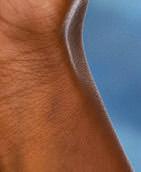


Before you visit campus this fall, don’t forget to download your free digital USC Alumni Association membership card! Enjoy 10% off at USC Bookstores and campus dining locations, as well as discounts on games, concerts, lectures and other fun activities. Log into FightOnline.usc.edu and request your card today. And while you’re there, check out our alumni directory, find events near you and much more!
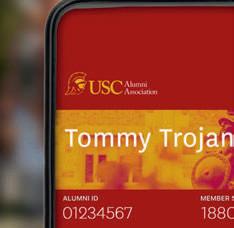
ee ff at ning n other nd hile mni and











|



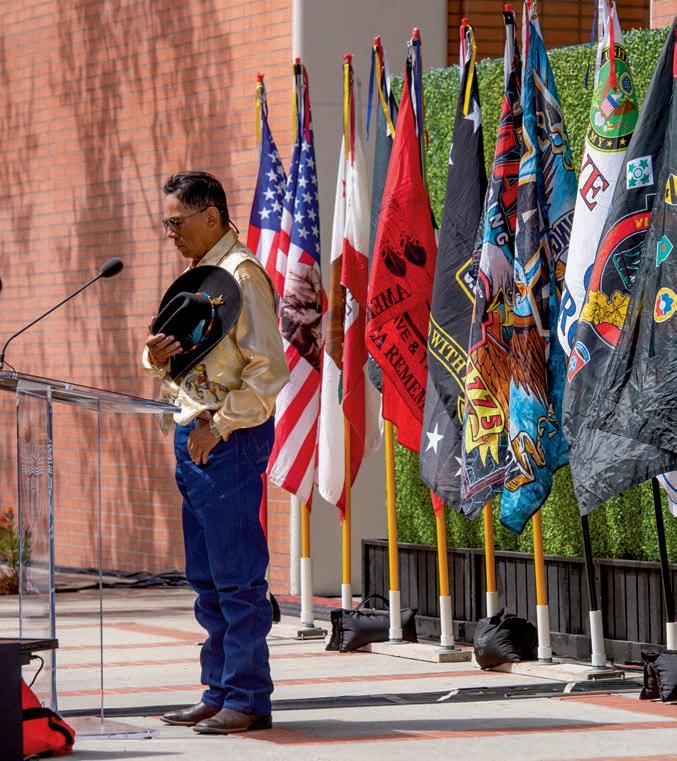
The university celebrates accomplished alumni.
At the 88th annual Alumni Awards gala in April, the Trojan Family celebrated seven notable leaders who showcase the best of the Trojan spirit. Honored for their stellar achievements and exemplary service, the 2022 USC Alumni Awards recipients were recognized for bringing distinction to the university.

This distinction celebrates accomplishments that reflect the range and quality of a USC education.
Mike Nyeholt ’78—Chairman emeritus, board of the Swim with Mike Physically Challenged Athletes Scholarship Fund A USC Marshall School of Business student, Mike Nyeholt was an NCAA All-American swimmer who was paralyzed in a motorcycle accident in 1981. Friends and teammates hosted a swim-a-thon fundraiser for Nyeholt, which inspired him to establish the Physically Challenged Athletes Scholarship Fund. Today, Swim with Mike is an annual
event that has raised more than $25 million for scholarships at 134 universities nationwide.
Mary Bono ’84—Former U.S. representative, 44th District; chair, Board of Directors for Community Anti-Drug Coalitions of America; chair and CEO, Mothers Against Prescription Drug Abuse Businesswoman and political leader Mary Bono served in the U.S. House of Representatives from 1998 to 2013 representing California’s 44th (now 45th) Congressional District. Widely recognized as an advocate for addiction prevention, treatment and recovery, and privacy and technology issues, she chaired the House Energy and Commerce Committee’s Subcommittee on Commerce, Manufacturing and Trade.
This award honors the achievements of an alumnus or alumna aged 35 or younger.
Adam Goldston ’09 and Ryan Goldston ’09 —Co-founders and co-CEOs, Athletic Propulsion Labs Identical twins Adam and
Ryan Goldston started Athletic Propulsion Labs in 2009, and in 2011, the White House recognized the Goldstons as part of Empact 100, a list of the top 100 entrepreneurs in the United States under 30. Since then, the two have been lauded for their entrepreneurial achievements and industrial innovation by organizations from Forbes to Goldman Sachs.
This recognition honors alumni volunteering efforts in service to the university.
Beth Petak-Aaron ’80—President-elect, Town & Gown of USC Beth Petak-Aaron has held numerous leadership positions in several university-affiliated groups, from the USC Alumni Association to the USC Convocations Committee. On the USC Alumni Association Board of Governors, she co-chaired various committees and events. With her husband, Tony Aaron ’80, she established USC-endowed scholarship funds for Town & Gown of USC and the USC Leventhal School of Accounting.
Ramona Cappello ’81—Longtime university volunteer Ramona Cappello served on the board of USC Marshall Partners and the USC Leventhal School of Accounting. From 2009 to 2015, Cappello served on the USC Alumni Association Board of Governors and was its president from 2013 to 2014. In 2014, she was elected to the USC Board of Trustees, where she chaired the Alumni Affairs Committee. She holds local and international leadership roles with the Young Presidents’ Organization.
Jules Buenabenta ’87—Longtime university volunteer Jules Buenabenta serves on USC Marshall’s Board of Councilors, is engaged in various USC Latino growth initiatives to foster diversity at the university and is a former member of the USC Alumni Association’s Board of Governors. He was recently appointed chair of President Joe Biden’s Advisory Commission on Advancing Educational Equity, Excellence, and Economic Opportunity for Hispanics.
Meet Nadine Watt, the new president of the USCAA Board of Governors.
Even though her career path veered away from the master ’s degree she earned at the USC School of Cinematic Arts, Nadine Watt MA ’94 credits USC for her success. After forging her own path in Hollywood for a decade, she decided to make a life change and go into the family business.
Her grandfather Ray Watt, who was a USC trustee from 1968 to 2009, founded Watt Companies, a diversified and fullservice real estate company. His advice? Lean on the Trojan family for support.
“One of the first resources that my grandfather had me take advantage of was the USC real estate community,” she explains. “Even though I had come from a completely different field, they welcomed me with open arms.”
At the USC Lusk Center for Real Estate, Nadine found mentors and friends, and eventually served on its executive committee. “My relationship with USC just blossomed from there,” she says.
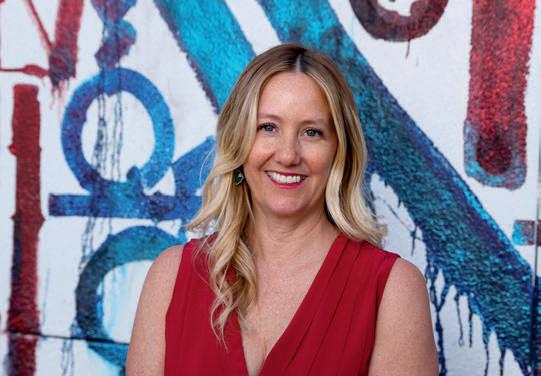
Her involvement at Lusk paved the way for her to become CEO of Watt Companies. Today, Nadine oversees day-to-day activities and strategic planning for all its commercial investment activities.
At USC, she has served on the boards of councilors of the USC Marshall School of Business and the USC Sol Price School of Public Policy, as well as the USC Associates Board of Directors. “From there, I realized that the natural progression of my volunteer time, leadership and philanthropy was to be on the Board of Governors,” she says. After being a board member for the past six years, she was elected president in May.
Nadine is looking forward to supporting USC President Carol L. Folt’s big initiatives in sustainability and diversity, equity and inclusion programs during her tenure. “The great thing about the Board of Governors is there are representatives from each school and affinity group at the university,” she says. “We know what the pulse of the alumni is.
Hopefully, that results in action at the top levels of the university.”
But Nadine is most excited about helming the 100th anniversary of the USC Alumni Association and the 100th USC Homecoming during the second year of her two-year presidency in 2023-24. Despite the COVID-19 pandemic triggering some of the organization’s most challenging times for alumni engagement, she sees a silver lining: “We have two years of experience in engaging alumni online, and we can leverage that.”
That means exploring hybrid alumni experiences: “We can have some events in person and some online, and people will remain engaged,” she says. “We also expand our reach to alumni who are further afield.”
Nadine says her business prowess and leadership skills set her up for success within her civic and philanthropic organizations. “You have to have humility, you have to have heart, you have to be honest, maybe have some humor,” she says. “Those translate across all platforms.”
Beyond that, USC has taught her to value her Trojan relationships. “I love the [USCAA description of the Trojan family being] ‘lifelong and worldwide,’” she says. “It’s absolutely true. When I’m hiring, interviewing and looking for interns, I go to my Trojan network first.”
She wants to make sure all USC alumni—and not just the fourth generation of Trojans in her family—get that support as well. “My daughter is entering USC next spring—I want her to have that opportunity, too,” she says. “Everything that USC has given me, I want to give back.”
LILLEDESHAN BOSENadine Watt MA ’94 is a huge supporter of the Trojan family. She says, “When I'm hiring, interviewing and looking for interns, I go to my Trojan network first.”
For Robert Spyksma, getting a second opinion at the USC Norris Comprehensive Cancer Center proved to be lifesaving. Fifteen years after his initial diagnosis, he is symptom free and leading a full life with his wife, Sarah, and their family. In gratitude, Robert and Sarah designated a charitable remainder unitrust (CRUT) to the USC El-K houeiry Cancer Research Fund, so that other patients may also get a second chance.
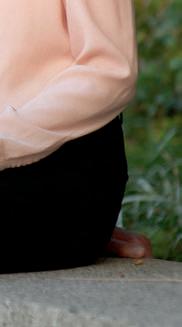


To create your Trojan legacy, contact the USC Office of Gift Planning at (213) 740-2682 or giftplanning@usc.edu. Please visit us online at www.usc.edu/giftplanning.
“We hope our gift can make a difference for someone else down the line.”


 Robert and Sarah Spyksma
Robert and Sarah Spyksma
Janet Boldt Saenz ’59 (EDU) was honored at a ceremony in recognition of her 63 years of continuous teaching and 28 years at the Autonomous University of Tlaxcala in Mexico.
Harry Feltman ’57 (BUS) has retired in Sedona, Ariz., after a long career in a range of positions, including in real estate sales, development and appraisal.
Oliver “Frank” Warren ’57 (BUS) has published An Adventure of Scribble Dog and Pointy Fox, the first in a trilogy of children’s books.
Jordan Colburn ’60 (BUS) has published a book on Amazon: Change the Way You Think About Raising Capital: How to Develop a Successful Mindset with a Proven Way to Raise Money.
John J. Gobbell ’60 (LAS) has published Somewhere in the South Pacific, the seventh novel in his series of historical thrillers.
Jack Nelson EdD ’61 (EDU) contributed a chapter, “Academic Freedom and IssuesBased Social Education,” to the second edition of Handbook on Teaching Social Issues.
Sonnee Weedn ’68, MS ’72 (EDU) received the Clark Vincent Award from the California Association of Marriage and Family Therapists for her contributions to clinical applications of research for her workbook 8 Ways to Wellbeing for Recovering People. Her documentary film on the life of former surgeon general Joycelyn Elders premiered at Philander Smith College in Little Rock, Ark.
Les Fettig MS ’69 (ENG) is the founder and managing director of Mandate Democracy Foundation.
Larry Curtis MS ’69 (ENG) worked in the High Energy Laser program and Plans and Programs for Tactical Weapons as an Air
Bob Falkenburg, who won the 1946 NCAA singles and doubles tennis titles at USC and went on to be a Wimbledon and U.S. Open champion, died on Jan. 6 in Santa Ynez, Calif., from natural causes. He was 95.

Known for his powerful serve, he won the 1948 Wimbledon singles title, fighting off three championship points, as well as the doubles crowns at the U.S. Open in 1944 with Don McNeill and at Wimbledon in 1947 with Jack Kramer. He teamed with his brother, Tom, in winning the 1956 NCAA doubles championship as Trojans. Falkenburg was inducted into the International Tennis Hall of Fame in 1974, the USC Athletic Hall of Fame in 2009 and the Southern California Tennis Association Hall of Fame in 2010.
He started a successful food and restaurant business in Brazil in the mid-1950s, opening a series of fast food and ice cream shops called Bob's. He became a Brazilian citizen and played Davis Cup matches for that country in 1954 and 1955.
Force officer and was the project officer for converting the Manned Orbiting Lab launch pad, Space Launch Complex 6, at Vandenberg Air Force Base to launch the NASA Space Shuttle. After retiring from the Air Force, he continued at Vandenberg as a contractor, launching Titan 2 and Titan 4 rockets.
Loren Latker MS ’71 (EDU) created “The Raymond Chandler Mystery Map of Greater Los Angeles,” which was part of the “Mapping Fiction” exhibition at the Huntington Library, Art Museum and Botanical Gardens.
Donald Leisey EdD ’73 (EDU) was inducted into the Wall of Honor by West Chester University of Pennsylvania College of Education and Social Work, his undergraduate alma mater.
Marcia Huffman Fritz ’74 (BUS) formed Coral Winds LLC, a publishing company, and co-wrote and published her first book, A Wretch Like Me
Mary Kenney JD ’75 (LAW) is a commissioner on the County of Los Angeles Citizens Redistricting Commission.
Dennis Neil Jones ’76 (SCJ), MPA ’78 (SPP) was named a California Super Lawyer in insurance coverage for the 15th time. He is a senior partner at Myers, Widders, Gibson, Jones & Feingold LLP in Ventura, Calif.
Joanne Pittroff ’76, MS ’78 (EDU) retired from the Pasadena Unified School District after 42 years of teaching at Daniel Webster Elementary School.
Ralph Winge ’77 DDS (DEN) has developed the Chaos Double-Brush Teeth-Cleaning Strategy, the seventh of his toothbrushing methods.
Lawrence Cohen PharmD ’78 (PHM) was named a Distinguished Professor at the University of North Texas Health Science Center at Fort Worth for his significant contributions to the university’s mission and his national and international prominence in the pharmacy profession.
John H. Daly III MS ’79 (ENG) has been elected to the Board of Trustees for Mott Community College in Flint, Mich.
Larry Davis ’79 (ENG) retired from the U.S. Air Force Civil Service as deputy director of the Test Division at Arnold Engineering Development Complex in Tennessee.
Deborah Berry ’80 (EDU) retir ed after 36 years of teaching. She most recently
worked as a teacher at West Hollywood Elementary School in the Los Angeles Unified School District.
Julie E. Green ’80 (LAS) joined Weintraub Tobin as of counsel in the firm’s corporate group as a result of a merger with Salem & Green.
Margaret M. Mann JD ’81 (LAW) , judge of the U.S. Bankruptcy Court for the Southern District of California, has been appointed as the bankruptcy judge observer to the United States Judicial Conference.
Russell M. Cummings ’82, PhD ’88 (ENG) of the U.S. Air Force Academy was awarded $1.5 million for his research by the University Consortium for Applied Hypersonics and the Department of Defense Joint Hypersonic Transition Office.
Michael Abels ’84 (MUS) appeared on the Today show in a segment on breaking down barriers in Hollywood and was featured in a Billboard story about composers helping to diversify the film scoring industry.
Laura Castañeda ’85, EdD ’10 (EDU) , a professor of professional practice at the USC Annenberg School for Communication and Journalism, has been named the school’s associate dean for diversity, inclusion, equity and access.
Steven A. Mindel JD ’85 (LAW) , chair of the Los Angeles County Bar Association's Family Law Section, was selected as one of Southern California’s 2022 Top 10 Super Lawyers. He is the managing partner at FMBK LLP.
Randall Miller EdD ’86 (EDU) is a senior consultant to the chancellor of Wayne County Community College District in Detroit, where he had served as executive vice chancellor and president of two of the district’s five campuses.
Stefan Zweig DDS ’86, CERT ’92 (DEN) , associate professor of clinical dentistry at the Herman Ostrow School of Dentistry of USC, was elected president of the American Association of Endodontists.
Douglas Tedford ’87, MS ’92 (EDU) leads Teaching Services Latin America, a Guatemala-based nonprofit committed to the development of effective teacher training systems for marginalized people.
Annee Della Donna JD ’88 (LAW) received the Anti-Defamation League Marcus M. Kaufman Jurisprudence Award and was named one of Orange County’s Most Influential People of 2021 by the Orange County Register.
Gary E. Hood ’88 (ENG) opened his own law firm, The Hood Legal Group, based in Seattle, focused on litigation, especially intellectual property and public interest. He was formerly with Polsinelli PC in Chicago.

Frederick W. Kosmo Jr. JD ’88 (LAW), named partner at Wilson Turner Kosmo LLP, was recognized as a 2022 San Diego Super Lawyer by the Super Lawyers rating service.
Rafael Alvarez MS ’89 (ENG) is director of the San Diego City College Mathematics, Engineering, Science Achievement Program, an academic support program for students transferring to four-year universities as STEM majors. He founded the City College MESA Program in 2000.
Helena Halmari MA ’92, PhD ’94 (LAS) is a Distinguished Professor of English at Sam Houston State University and a Texas State University System Regents’ Professor.
Eduardo Hernandez ’92 (LAS) co-founded EigenRisk, a technology company specializing in catastrophe and climate change risk analytics and modeling.
Usha Patel ’92, MS ’95 (ENG) was recognized by the U.S. House of Representatives for her exceptional service to the community and for her work promoting women in engineering.
Left The National World War I Memorial opened in April 2021 on the site of Pershing Park in Washington, D.C., named for John J. Pershing, who served as General of the Armies during the war. Below Chris Isleib ’85 stands before the National World War I Memorial in Washington, D.C.
USC Dornsife alumnus and Navy captain Chris Isleib helped create the first national memorial for World War I veterans, part of a long career spent telling the stories of America’s military.
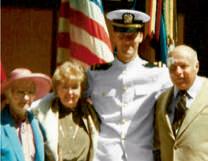
World War I is one of America’s most forgotten wars, says Chris Isleib ’85, a retired Navy captain with nearly 30 years in the service. When he began recruiting volunteers for the United States World War One Centennial Commission in 2013, he asked each person if they had a family member who served in the conflict.
“Hardly anyone knew,” Isleib says. Although the U.S. mobilized more than 4 million men and women and lost nearly 120,000 soldiers during the war, there had been no official memorial built at the nation’s capital in the 100 years since the conflict.
It took effort from people like Isleib, who served as director of public affairs for the Centennial Commission, to secure land and funding to build a memorial.
In April 2021, the site was first opened to visitors. In 2024, the installation of a 58-foot bas-relief by the artist Sabin Howard will mark its completion. The sculpture, titled “A Soldier’s Journey,” depicts the experiences of those who served.
It was a fitting accomplishment for Isleib, who graduated from the USC Dornsife College of Letters, Arts and Sciences with a degree in creative writing in 1985. He’s spent his career telling the stories of the military, from Hollywood to the Pentagon, to make sure they don’t get lost.
“It’s always been important for me to tell good stories about our troops, stories about their moral courage, physical courage and integrity,” he says.
A college scholarship through the Naval Reserve Officer Training Corps (ROTC) program brought Isleib from the East Coast to USC. After graduation, Isleib trained to drive naval ships in Newport, R.I., then was assigned to the USS Iowa. He ended up back in Los Angeles to work in the entertainment industry, writing scripts and consulting on film and TV productions through the Navy’s Hollywood liaison office.
Isleib served in the Office of the Secretary of Defense within public affairs and eventually transitioned to civilian status. In time,
he became the director of communications at the National Archives. It was there that he learned about the Centennial Commission and became one of its first volunteers, helping raise nearly $50 million in private donations for the memorial.
For Isleib, the Great War deserves considerable recognition beyond just memorializing its fallen soldiers. It changed America’s perception of its role on the world stage and brought the country fully into the modern era.
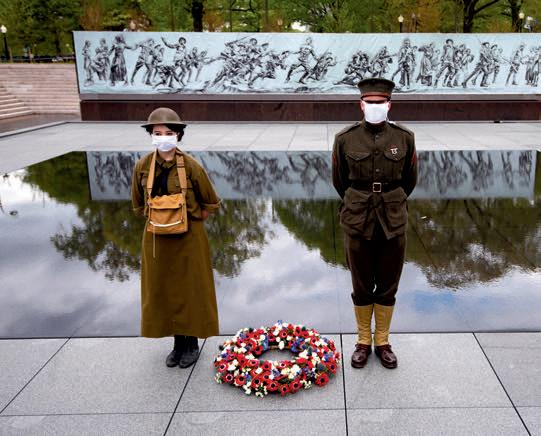
“This was the first time that Americans had gone overseas with the idea of protecting democracy,” he says. “We went from a farming country to advances like telephones, submarines, airplanes and chemotherapy by the end of the war. It was astonishing.”
MARGARET CRABLELeticia Gallegos Espinoza ’94 (LAS) received the Professional Achievement Award in June 2022 from the Mexican American Bar Foundation. She is the chief legal officer and corporate secretary at Cardenas Markets LLC.
Chris Martine ’94 (ENG) retired from the corporate and management consulting world
to advance his commitment to social justice.
Igbodike Obioha JD ’95 (LAW) joined the Sanders Roberts LLP Entertainment Practice Group in the Los Angeles office.
Mykle McCoslin ’96 (DRA) appears in Paramount Pictures’ action thriller Little
▲ Kevin Stephens MBA ’92 (BUS) was appointed to the board of directors of Keysight Technologies.
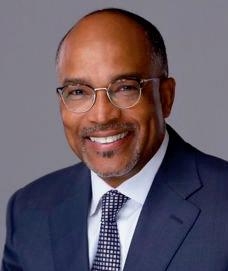
Elizabeth Atlee JD ’93 (LAW) of CBRE Group Inc., Lisa Harrington JD ’93 (LAW) of Viant Technology Inc., Gavin Galimi JD ’00 (LAW) of Strategem Investments LLC and Thomas Wehinger LLM ’14 (LAW) of Regent LP were honored as nominees for the Los Angeles Times 2022 In-House Counsel Leadership Awards.
Kay Faulconer Boger EdD ’93 (EDU), former acting vice president of instruction at the San Diego College of Continuing Education, assumed the role of interim president after the previous president, Carlos O. Turner Cortez PhD ’06 (EDU), became chancellor of the San Diego Community College District.
Robert Dugdale JD ’93 (LAW), Stephen Larson JD ’89 (LAW) and David Willingham JD ’98 (LAW) were named to the Daily Journal's Top White-Collar Lawyers of 2021.
Janice Filer EdD ’93 (EDU) teaches at the university level after retiring from Long Beach Unified School District as a high school principal. She recently graduated from Pepperdine University with a PhD in global leadership and change.
Stephanie Sylvestre ’93 (LAS) was accepted into Harvard’s Advanced Leadership Initiative, a yearlong interdisciplinary academic learning, leadership development and peer-to-peer collaboration.
Olympian, co-captain of the USC 1958 National Championship track and field team and one-time worldrecord-holding discus thrower Richard Aldrich "Rink" Babka ’58 died on Jan. 15 due to congestive heart failure at the age of 85.
Babka, one of the greatest discus throwers in USC history, was among the first throwers to break the 200foot mark. The three-year (1956-58) letterman co-captained USC’s 1958 NCAA championship team and was the NCAA co-champ in the discus as a senior. His best Trojan throw of 198-10 still ranks tied for fifth in USC history. A world and American record holder in the discus throw, Babka won a silver medal at the 1960 Rome Olympics. The two-time All-American helped found the International Track Association, the sport’s first pro group.
Babka was a business entrepreneur and an artist who owned a successful beverage distributorship in Stockton, Calif., where he also raised quarter horses and cattle. He was inducted into the USC Athletic Hall of Fame in 2009.

Dixie. She is the local president of SAGAF TRA in Houston and Austin, Texas.
Neil Rotter ’94 (GRN), MS ’96 (SSW) is CEO of Libertana, a health care and social service organization serving fragile, vulnerable patients with long-term nursing needs by providing home health care.
Roberto Larios ’97 (LAS) was appointed chief executive officer of the Employees Club of California, the third CEO in the organization’s 93-year history.
Keith Ellis Cooper JD ’98 (LAW) retired from the practice of law and relocated to Charlotte, N.C., to enjoy his retirement.
Jamie Gold MA ’98 (SCJ) , author of Wellness by Design: A Room-by-Room Guide to Optimizing Your Home for Health, Fitness and Happiness, received a Robert Bruss Book Award at the 2021 National Association of Real Estate Editors conference.
Matthew Wein JD ’99 (LAW) is general counsel of Mustang Bio Inc., a clinical-stage biopharmaceutical company focused on translating medical breakthroughs in cell and gene therapies into potential cures for cancers and rare genetic diseases.
Devi Zinzuvadia ’99 (LAS), MSL ’20 (LAW) was named public information officer for the San Francisco Human Rights Commission, a municipal enforcement agency in service of equity and nondiscrimination.
Lance Brady JD ’00 (LAW) was named partner at Wilson Sonsini Goodrich & Rosati with a practice focus on representing public and private life sciences and technology companies through all stages of growth.
Jennifer Berson JD ’01 (LAW) and her public relations mentoring business, Profitable PR Pros. were honored with the silver award in
the advertising and marketing category of Inc. Magazine's 2021 Best in Business Awards.
Janette Brown ME ’01, EdD ’04 (EDU) received the 2021 Association of Retirement Organizations in Higher Education Higher Education Retirement Organization (HERO) Distinguished Leadership Award for significant contributions, distinguished leadership and service.
Matthew Fleishman ’01 (BUS) has joined Inspirage LLC as a senior manager specializing in solution architecture in the supply chain practice.
Jim Oliva JD ’01 (LAW) was promoted to associate general counsel, litigation division lead, at American Honda Motor Co. Inc.
Juanita E. Mantz JD ’02 (LAW) published a young adult memoir, Tales of an Inland Empire Girl
Jennifer Vega La Serna PhD ’02, MS ’04 (EDU) is assistant superintendent and vice president of academic services at the College of the Sequoias in Visalia, Calif. She received the Carter Doran Leadership Award in 2022 from the California Community Colleges Chief Instructional Officers for her statewide work on diversity, equity and inclusion.
James C. Suits II JD ’03 (LAW) is chief executive officer of San Jose, Calif.-based Suits Litigation Inc., representing plaintiffs in personal injury matters throughout California.
Daniel Guggenheim JD ’04 (LAW) has been elected as a fellow by the American College of Real Estate Lawyers, an invitation-only organization of nationally known real estate lawyers in the United States.
Carlos Rafael Rivera MM ’04, DMA ’10 (MUS) was a co-winner in the category of Best Score Soundtrack for Visual Media for The Queen’s Gambit, along with the score for Soul, at the 64th Grammy Awards.

Diidri Robinson JD ’04 (LAW) was promoted
to vice president, chief ethics and privacy officer, at Anthem Inc.
Christopher Elliott ’05 (MUS), JD ’09 (LAW) has been named partner at Mitchell Silberberg & Knupp LLP.
Serena Gould MS ’05 (EDU) earned her PhD in English literature and criticism from Indiana University of Pennsylvania.
Amanda Oliver JD ’05 (LAW) was appointed senior vice president and general counsel for NASCAR.

Sherry-Maria Safchuk ’05 (LAS) has been promoted to partner in the Los Angeles law offices of Buckley LLP.
▲ Paul Wiancko ’05 (MUS) was named one of The Washington Post’s 22 composers and performers to watch in 2022.

Patricia Brum MBA ’06 (BUS) was elected officer and secretary of the Inner-City Arts board of directors in Los Angeles.
M. Mendel Trapedo LLM ’06 (LAW) was promoted to special counsel at Kramer Levin Naftalis & Frankel LLP, where he represents clients in a range of real estate transactions.
Veronica Arteaga MSW ’07 (SSW) is president and CEO of the board of directors of the Exceptional Children’s Foundation, a nonprofit organization that provides services to children and adults with special needs and their family members. She previously served as chief
program officer for Wayfinder Family Services and vice president of housing programs for St. Anne’s Family Services in Los Angeles.
Meghan Gray ’07 (LAS) was promoted to the rank of commander in the U.S. Navy in September 2021 and assigned to the USS Charleston. She previously served 14 years in the U.S. Navy as a surface warfare officer.
Amir Kaltgrad JD ’07 (LAW) joined the Carlton Fields Los Angeles office as of counsel, representing businesses and individuals in a variety of commercial litigation matters.
Damita Miller EdD ’07 (EDU) is an instructional director and principal supervisor of elementary schools in Long Beach Unified School District.
Austin Wintory ’07 (MUS) was nominated for a 2022 Society of Composers & Lyricists Award for his work on the multiplayer game Aliens: Fireteam Elite. He also composed the score for the game Journey , the first Grammy Award-nominated score for a computer game.
Jackie Jaskowiak PharmD ’08 (PHM) is inpatient pharmacist specialist, Compounding Compliance and Operations, at UC San Diego Health. She also published an article in the American Journal of Health-System Pharmacy.
James Kramer ’08 (BUS), JD ’12 (LAW) was named partner at Procopio, Cory, Hargreaves & Savitch LLP.
Amit Makker ’08 (ENG), JD ’11 (LAW) and Jonathan Shih JD ’12 (LAW) were promoted to counsel at Latham & Watkins LLP.
Erik Ohlson MA ’08 (EDU) is visual and performing arts teacher on special assignment in Santa Rosa City Schools in Santa Rosa, Calif. He also welcomed a baby to his family.
Signo Uddenberg ’08 (ENG) is owner of a restaurant, Somos, that was featured in a National Geographic article titled “A Culinary Guide to Quito, Ecuador.”
Jonathan Horn MA ’09 (SCJ) is the community relations manager for the city of Carlsbad, Calif.
Jonathon Hyde EdD ’09 (EDU) is dean of students at Pacific University in Forest Grove, Ore.
Kameryn Craig ’10 (LAS), an Olympic gold and silver medalist in water polo, was recognized by the Santa Barbara County Board of Supervisors during Dyslexia Awareness Month.
Marina Dompke MCM ’10 (SCJ) is vice president of TV and film at Three Rivers Entertainment and was a producer on the CBS comedy How We Roll
Steffi Gascón Hafen JD ’10 (LAW) of Snell & Wilmer has been selected for inclusion in San Diego Metro Magazine's 2022 Women of Accomplishment, recognizing outstanding women in the San Diego area.
Xiaoxi (Xixi) Hu ’10 (ENG) was nominated for Woman of the Year by the Leukemia and Lymphoma Society.
Engineer Award at WE21, an international conference for women in engineering.
Stephen Blaker JD ’11 (LAW) founded a boutique immigration law firm, Blaker & Granet LLP, that provides legal services to individuals and employers navigating the U.S. immigration process for family or employment-based immigration.
Sriram Chatrathi MBA ’11 (BUS) is senior vice president of product management at ExecOnline, an online leadership development company. He joined the organization after working at Adobe, Yahoo, Symantec and other organizations.
Shaun Gordon ’11 (BUS), JD ’14 (LAW) was elected shareholder at Weintraub Tobin, where his practice encompasses all aspects of the entertainment industry.
Sarah Luetto JD ’11 (LAW) was elevated to partner at Hersh Mannis LLP, a firm dedicated to family law.
Brandon Reilly JD ’11 (LAW) was recognized by the Daily Journal as a 2022 Top Cyber Lawyer.
Emily Reyes MAT ’11 (EDU) is a third-grade teacher at Laurel Cinematic Arts & Creative Technologies Magnet School in Los Angeles and is chapter vice chair for United Teachers Los Angeles and executive vice president for the Asian Pacific American Labor Alliance, Los Angeles chapter.
John Snow JD ’11 (LAW) was promoted to partner at King, Holmes, Paterno & Soriano LLP.
Dale Trumbore MM ’11 (MUS) was named one of The Washington Post’s “22 Composers and Performers to Watch in 2022.”
▲ Vimbayi Kaziboni ’10 (MUS) guestconducted the L os Angeles Philharmonic New Music Group in a program that included two world premieres of pieces by Wadada Leo Smith and inti figgis-vizueta.
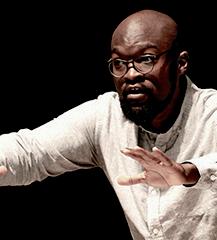
Stephen E. Baumann II JD ’11 (LAW) and Jyoti Mittal JD ’12 (LAW) were elevated to shareholders at Littler Mendelson PC.
Nadia Bess ’11 (ENG) received the Society of Women Engineers Distinguished New
Ali Abugheida JD ’12 (LAW) was promoted to partner at Buckley LLP and represents corporate and individual clients in a variety of litigation and government enforcement matters.
Aaron Chiu JD ’12 (LAW) and Darren Guttenberg JD ’13 (LAW) were named partners at Latham & Watkins LLP.
Olivia Clare Friedman MPW ’12 (LAS) published her first novel, Here Lies, which
In 2020, Hiram Sims ’05, MPW ’07 (LAS) opened the Sims Library of Poetry, a space for people from Inglewood and the rest of Los Angeles to read, write and create.
Hiram Sims wanted to give poetry a home.
And he wanted to do it in his home: Inglewood, Calif. “I wanted to create a space where people from the neighborhood could come to read and write, to think,” says Sims, who graduated with both a bachelor’s and master’s degree from the USC Dornsife College of Letters, Arts and Sciences.
So in 2020, he opened the Sims Library of Poetry in a small building that features 7,250 books of poetry, several computers with internet access and a small private writing room. It is the first poetry library in the state of California; most of the books are by poets of color.
“I live in the neighborhood. And I wanted this space to be a part of this community,
which is primarily made up of really wonderful Black and brown people,” Sims says.
Sims explains that the library aims to have a symbolic presence as well as a physical one.
“Sometimes when you tell people you want to write poetry, they act like it’s trivial. But then you come into a space like this and you see people who take it seriously,” he says. “Places like this validate the part of you that has a desire to do it.”
Sims has always fostered others’ desire to write. Shortly after leaving USC, he formed Urban Poets, a creative writing workshop that he ran out of his living room. He also taught poetry courses at different colleges in the L.A. area.


In 2013, Sims founded the Community Literature Initiative, a nonprofit dedicated to teaching writers of color how to create
and publish books. He worked out an agreement with USC to teach courses to the public using space provided by the university, which is when he launched the first incarnation of the Sims Library—a small suitcase full of poetry books.
“My students said they couldn’t do the required reading because they had no access to poetry books,” he explains. “So, I decided to put 80 of my own books in that suitcase and brought it to class every week.”
When one student called the bookbag the “Sims Library,” Sims got an idea.
He wanted to spread poetry to more people, especially those in his Inglewood community. He began by filling bookshelves in his garage with the books he owned—but the space looked a bit sparse.
“I called every poet I knew and said, ‘Hey, I'm opening a poetry library in my garage. Will you please come and donate books?’” he recalls. Poets, family, friends and community members donated more than 2,000 books of poetry.
From there, the Sims Library—which reflects the community by featuring many works by poets of color and poets from the Inglewood area—expanded to a bigger, standalone location.
He says, “It really is a library created by the poetry community itself.” MEREDITH MCGROARTY



was reviewed in The New York Times and on NPR.
Sohrab Izadi JD ’12 (LAW) was promoted to Tax Counsel III at the California Department of Tax and Fee Administration.
Kristen Kavanaugh MSW ’12 (SSW) received the USC Lambda Alumni Association Recognition Award for Merit at the USC Lambda LGBT Scholarship Gala in April 2022.
Derek Lipkin JD ’12 (LAW) was promoted to the role of senior counsel, delivery, at Uber Technologies Inc.
Diana Newman ’12, MM ’14 (MUS) made her Metropolitan Opera debut as Papagena in The Magic Flute in December 2021.

Shawn Obi JD ’12 (LAW) was promoted to partner at Winston and Strawn LLP, where her practice focuses on complex commercial litigation.
Jonathan Shih JD ’12 (LAW) has been promoted to counsel at Latham & Watkins LLP in Los Angeles, where he represents private equity sponsors and private and public company borrowers in domestic and cross-border commercial lending transactions.
Nadine Tan BA ’12 (BUS), JD ’15 (LAW) was named associate counsel at Green Dot Public Schools California and completed her first year teaching legal profession in the USC Gould School of Law’s LLM program.
Elizabeth Torres MAT ’12 (EDU) was selected by the mayor of Denver to serve on the Energy Committee for the City and County of Denver’s Sustainability Advisory Council.
Jennifer L. Bryant JD ’13 (LAW) was named partner at Munger, Tolles and Olson LLP. Her practice focuses on complex commercial litigation with an emphasis on legal challenges faced by the entertainment and technology industries.
Gina Luciani MM ’13 (MUS) , Karoline Menezes MM ’15, GCRT ’17 (MUS) , Elise Solberg ’18 (MUS) and India Anderson ’21 (MUS) joined Beyoncé for her performance of the Oscar-nominated song “Be Alive” from the film King Richard for the 2022 Academy Awards ceremony.
Morgan E. Smith JD ’13 (LAW) was promoted to partner at Finnegan, Henderson, Farabow, Garrett & Dunner LLP, where she focuses on trademark, copyright and false advertising litigation.
Alison Weinberg-Fahey JD ’13 (LAW) was advanced to partner at Manatt, Phelps & Phillips, LLP in Los Angeles, where she focuses on commercial real estate transactions.

Natalie Alvarez ’14, MS ’15 (ENG) was selected as a Woman of Influence in Engineering by the San Diego Business Journal.
Ryan C. Baker MBA ’14 (BUS) was promoted to vice president of the Douglas
Wilson Cos., a real estate development, receivership and advisory firm, where he leads the fiduciary practice.
Joshua Love JD ’14 (LAW) was promoted to partner at Reed Smith LLP, focusing his practice on the music and entertainment industry.
Ashima Sharma ’14 (ENG) founded a mentorship platform called Dreami to make career development more equitable.
Elizabeth Trayner EdD ’14 (EDU) was recognized with University of the Pacific’s 2021 Woman of Distinction Award. She is the university’s Title IX coordinator.
Nancy Dayne EdD ’15 (EDU) is an associate professor at California State University, Long Beach, in the area of child development and family studies.

Ema Flores EdD ’15 (EDU) was named superintendent of the West Covina Unified School District in West Covina, Calif.
Anthony Maciel EdD ’15 (EDU) is associate vice president and chief information systems officer at MiraCosta College in Oceanside, Calif.
Vallery Lomas had a baking gene that was slow to emerge. After graduating from the USC Dornsife College of Letters, Arts and Sciences with a degree in psychology, she completed a law degree from the USC Gould School of Law and practiced law for eight years.
During that time, she began baking as stress relief, then started a food blog before eventually winning the third season of The Great American Baking Show, part of the same franchise that produces the popular Great British Baking Show. She was the first Black winner in the franchise’s history.

Her cookbook, Life Is What You Bake It (Clarkson Potter, 2021), traces this path from lawyer to baker and the ups and downs along her career change—including the fact that her winning episode never aired.
Lomas, who grew up in Baton Rouge, La., came to USC because her sister Lucy was a biomedical engineering student at the USC Viterbi School of Engineering. After a weeklong visit in her junior year of high school, where she was surrounded by a mix of Black and international students, she knew USC was where she wanted to go to school.
“I didn’t really apply to other colleges. I knew I was going to USC.”
After graduating from USC Dornsife with a psychology degree, she enrolled at the USC Gould School of Law. By then, her sister was a medical resident at the Keck School of Medicine of USC; together, they shared an apartment. That’s when Lomas began baking to relieve stress—a habit she kept after moving to New York City, taking a job in privacy law. She spent nights and weekends baking, blogging and Instagramming her creations.
That’s where a casting director for The Great American Baking Show found her and suggested she audition. While Lomas excelled in the competition, the show never aired because one of the show’s judges was accused of sexual harassment, and ABC pulled the final episodes from broadcast.
It was a major disappointment, but it sparked an important career change.
“After the baking show got canceled, I was back at work and just burnt out. I knew I wanted to write a book, to talk about my experiences and how I felt. But I was going to work all day, and I didn’t have the energy to write the proposal. So, I left my job,” says Lomas.
For Lomas, quitting her job to write a book was a risky bet on herself that came with rewards. Life Is What You Bake It was named one of the best cookbooks of 2021 by the The Washington Post and the Boston Globe.
“There are stories in the book about my grandmother, the evolution of recipes, the Hollywood handshake. Having that storytelling component was probably as important as the recipes for me,” says Lomas. “Pieces of me are in this book."
MARGARET CRABLEGrace Mandl ’15 (ART) had her first permanent solo exhibition at Lenox Towers in Atlanta featuring 30 commissioned largescale abstract oil paintings.
Thai V. Phan JD ’15 (LAW), a municipal law attorney at Rutan and Tucker LLP, was promoted to city attorney for the city of Duarte, Calif.

Sal Phillips JD ’15 (LAW) is lead counsel of global privacy incidents at the technology company Meta.
Lyndsie Russell JD ’15 (LAW) has been named equity partner at Miles, Sears & Eanni, where she practices civil litigation with an emphasis on plaintiff’s catastrophic injuries.
Jillian (Kovler) Skinner ’15 (LAS) joined Dean Mead Orlando as an associate practicing in business litigation and labor and employment law.
Mario Enriquez MPA ’16 (SPP) has been named director of the Intercultural Student Success Center at the University of the Pacific in Stockton, Calif.
Kimberly MacKinney EdD ’16 (EDU) was named 2021 Curriculum and Instruction Administrator of the Year by the Association of California School Administrators. She is an assistant superintendent at Oro Grande School District in San Bernardino County, Calif.
Jasmine Naseri ’16 (ENG) received the 2021 Society of Women Engineers Rising Technical Contributor Award for outstanding contributions to the safety and performance of satellite payload subsystems and for technical depth, energy and drive that delivers results under pressure.
Jeremy Allam MS ’18 (ENG) co-founded a space technology company called Exo-Space that raised its initial round of financing for its first launch into space.
Amie Carter EdD ’18 (EDU) is an assistant superintendent in the Marin County Office of Education in San Rafael, Calif.
Michael Parks, the esteemed former director of USC Annenberg’s School of Journalism and former editor of the Los Angeles Times, died at the age of 78 on January 8 following kidney failure and a heart attack.
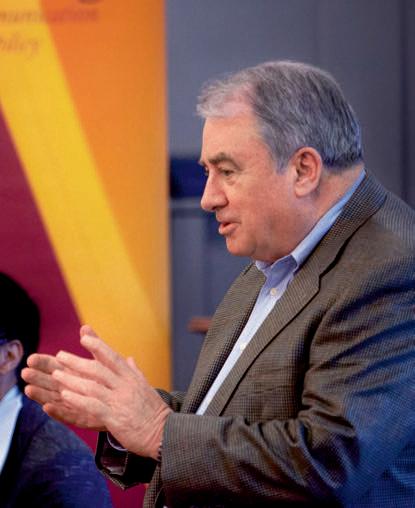
Parks’ newspaper career began with his hometown paper, the Detroit News, and spanned nearly 40 years. He was awarded the Pulitzer Prize for International Reporting in 1987 for his coverage of the struggle against apartheid in South Africa. In 1997 he took the helm of the Times as editor and led the nation’s largest metropolitan newspaper for the next three years.
He joined the USC Annenberg faculty in 2000, where he was devoted to training, mentoring and inspiring the next generations of journalists and advancing the field of journalism education.
Before retiring in 2020, Parks was instrumental in guiding the creation and adoption of an innovative core curriculum that trains students to report stories for print, broadcast and new media.
Parks is survived by his wife, Linda, and their sons Christopher and Matthew. He is preceded in death by their daughter Danielle.
Camille Edwards ME ’19 (EDU) is an executive assistant at The Late Show with Stephen Colbert in New York City.
Diontrey Thompson EdD ’18 (EDU) was named head of diversity, equity and
inclusion at Noom Inc.
Aerial Ellis EdD ’19 (EDU) was named the Wells Fargo Endowed Chair and Distinguished Professor at North Carolina Central University in Durham, N.C.
Kafele Khalfani EdD ’19 (EDU) was named vice president of student experience at California Institute of the Arts in Valencia, Calif.
Mark Mathews EdD ’19 (EDU) is an adjunct professor in the security management graduate program at the University of Houston-Downtown in Houston.
Jake Silverman DMA ’19 (MUS) won a Grammy Award in the category of Best Arrangement, Instrumental or A Cappella for “Meta Knight’s Revenge” from the game Kirby Superstar.
Yiwei Lu ’20 (LAS) opened Yiwei Gallery in Venice Beach, Calif., and was named to the 2022 “AACYF Top 30 Under 30” list by All America Chinese Youth Federation, the Los Angeles Post and the Chinese American Institute for Public Diplomacy.
Linda de la Torre EdD ’21 (EDU) was named acting superintendent of San Marino Unified School District in San Marino, Calif.
Teresa Cheng ’09 (LAS) and Joel Ulloa ’09 (LAS).
Vicki Huang MBA ’17 (BUS) and Ben Salzman MBA ’19 (BUS).
Michael Richman ’05 (SCJ) and Devra Rottman Richman ’10 (SSW), a daughter, Sofia.
Ani Altounian ’10 (LAS), PharmD ’14 (PHM) and Dickran Altounian ’10 (LAS), MS ’11 (MED), a son, Andrew Jack.
Annie (Faulkner) Wagner ’11 (LAS) and Brian Wagner ’12 (SCJ), a son, Finnegan Matthew Wagner.
Melissa Gillespie ME ’11 (EDU) and Carlton Gillespie, a daughter, Sienna Joy Gillespie.
Eva Hinojoza ME ’11, EdD ’17 (EDU) and Manuel Valencia, a son, Dylan Jose Valencia.
Dieuwertje Kast ’11, MAT ’14, EdD ’20 (EDU) and Roee Fung, a son, Grayson.
Janet Schmidt ME ’15 (EDU) and Russell Schmidt MS ’19 (EDU), a son, Eli Schmidt.
Ariel (Gonzalez) Shasteen ’11 (SCA) and H. E. Joseph Shasteen ’11 (BUS), a son, Harlen Edwin Benjamin.
Irving Gordon ’46 (LAS) of Carlsbad, Calif.; Nov. 6, 2021, at the age of 95.
Carlos H. Reynales ’46 (BUS) of Long Beach, Calif.; Aug. 31, 2021, at the age of 99.
Doris Yip ’46 (LAS) of Los Angeles, Calif.; Feb. 27, 2022, at the age of 97.
Richard Coswell ’47, MA ’51 (LAS) of West Roxbury, Mass.; Feb. 12, 2022, at the age of 95.
Richard Mogan III ’47 (LAS) of Rancho Mirage, Calif.; Sept. 9, 2021, at the age of 97.
Paul Trejo ’47 (LAS) of Newburgh, Ind.; Sept. 15, 2020, at the age of 93.
Howard Ellsworth Jessen MS ’48 (ENG) of Winnetka, Ill.; Sept. 29, 2021, at the age of 96.
Suzanne Sadler Stone ’48 (ART) of Tustin, Calif.; Dec. 29, 2021, at the age of 95.
James Cobble MA ’49 (LAS) of La Jolla, Calif.; Nov. 12, 2021, at the age of 95.
Alice Harvey Goldberg ’49 (ENG) of Seattle; March 16, 2021, at the age of 94.
June (Barcroft) Prowell ’49 (LAS) of Davis, Calif.; Mar. 11, 2022, at the age of 94.
Raymond Wintroub ’49 (LAS), MD ’55 (MED) of Rolling Hills, Calif.; Nov. 15, 2021, at the age of 96.
Barbara Lea Jury ’50 (SSW) of Los Angeles; Nov. 16, 2021, at the age of 94.
Violet Steiner ’50 (ART) of Concord, Calif.; May 29, 2022, at the age of 94.
Donald Anderson ’51 (ENG) of Redondo Beach, Calif.; Dec. 24, 2019, at the age of 93.
Katherine Fixa ’51 (EDU) of Brea, Calif.; Oct. 3, 2020, at the age of 92.
Philip Field ’52 (ENG) of Bakersfield, Calif.; Jan. 23, 2021, at the age of 91.
Winston Goller ’52 (EDU), MA ’71 (ENG) of Dana Point, Calif.; April 13, 2022, at the age of 91.
Max Stanford Tomlinson ’57 (LAW) of La Quinta, Calif.; Oct. 30, 2021, at the age of 91.
Robert Bell ’53 (ENG) of Palos Verdes, Calif.; February 2021, at the age of 92.
Vincent Dundee ’53 (BUS) of Glendale, Calif.; Sept. 2, 2021, at the age of 90.
Samuel Longo Sr. ’53 (ENG) of La Canada, Calif.; Dec. 20, 2020, at the age of 91.
Conn Francis Findlay ’54 (ENG) of San Mateo, Calif.; April 8, 2021, at the age of 90.
Richard Bauer DDS ’55, MA ’62 (DEN) of Flagstaff, Ariz.; Dec. 23, 2021, at the age of 92.
William Earnshaw ’56 (LAS) of Bedford, N.H.; Feb. 6, 2022, at the age of 95.
Richard Nola ’56 (LAS) of San Jose, Calif.; Sept. 2, 2021, at the age of 89.
Bill Ridgeway ’56 (LAS) of Long Beach, Calif.; Aug. 20, 2021, at the age of 88.
Sherman Weiss ’56 (LAS) of Los Angeles; Feb. 10, 2022, at the age of 86.
William Arnett ’57 DDS (DEN) of Laguna Hills, Calif.; Feb. 14, 2022, at the age of 99.
Frank Besag ’57 (LAS), MS ’63, PhD ’65 (EDU) of Jacksonville, Fla.; April 25, 2021, at the age of 85.
Douglas Maijala BS ’57, MS ’61 (EDU) of Paso Robles, Calif.; Sept. 18, 2021, at the age of 91.
Barbara Hancock Reynolds ’58 (LAS) of Hilton Head, S.C.; June 5, 2021, at the age of 84.
Richard "Rink" Babka ’59 (BUS) See Trojan Tribute on page 84.
Richard S. Jonas MD ’59 (MED) of Laguna Beach, Calif.; Feb. 16, 2022, at the age of 93.
Carol Jean Howe ’60 (LAS) of Camarillo, Calif.; March 14, 2022, at the age of 83.
James Lamhofer ’60 (LAS) of Long Beach, Calif.; Jan. 14, 2022, at the age of 93.
Donald Germino ’61 (LAS) of Los Banos, Calif.; Jan. 19, 2022, at the age of 82.
Thomas “Ray” Davies DDS ’62 (DEN) of Newport Beach, Calif.; Nov. 19, 2021, at the age of 84.
Britt Williams ’62 (LAS) of San Mateo, Calif.; Aug. 2, 2021, at the age of 80.
Wayne McKinney PhD ’63 (LAS) ; Jan. 17, 2021, at the age of 91.
Renaldo Parisi ’63 (DEN), PhD ’68 (LAS) of Pasadena, Calif.; Jan. 20, 2021, at the age of 84.
Laurel Herbst ’65 (LAS) of San Diego; Oct. 22, 2021, at the age of 76.
Martin Pilmanis ’65 (ENG), MBA ’68 (BUS) of Rancho Palos Verdes, Calif.; Sept, 28, 2021, at the age of 78.
Roger Krauel ’66 (LAS) of Escondido, Calif.; June 11, 2021, at the age of 77.
Douglas Swartz ’66, MBA ’68 (BUS) , of Palm Desert, Calif.; Oct. 15, 2021, at the age of 77.
Michael Mayock ’67 (LAS) of South Pasadena, Calif.; Dec. 27, 2021, at the age of 77.
Jerry Shafer PhD ’68 (LAS) of Concord, Calif.; Nov. 21, 2021, at the age of 79.
A USC Leventhal School of Accounting alumnus, entrepreneur, donor and longtime friend to the university, Ronald J. Kuhn ’69 came to USC from his home in Illinois to learn accounting and business skills that would serve him throughout his life.
After graduation, he transformed his family construction business, Harry W. Kuhn Inc., into a Chicago-based powerhouse where he served as chairman and CEO until 2011. He also founded Pillar Rock, a small-batch wine produced from his vineyard in Napa Valley.
As a young man, a snowmobile accident left Kuhn in a coma for a month, forcing him to relearn how to walk and talk. The experience inspired his later philanthropy, and he established the Ronald J. Kuhn Student Fellowship Fund at Leventhal with this in mind.
In 2013, Kuhn received the USC Leventhal School of Accounting Distinguished Alumnus Award; in 2018 he made a $4 million gift to support the renovation of the 90-year-old accounting building into a state-of-the-art facility. The foyer of the renovated building will be named for him in recognition of his support.
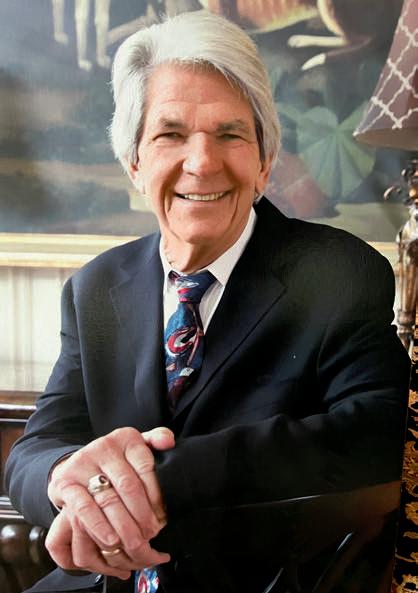
Kuhn, who died on May 25, is survived by his two children, Stephen Kuhn and Kerri McLean; four grandchildren; and his aunt.
COURTESY OF THE KUHN FAMILYEdra Bogle PhD ’69 (LAS) of Denton, Texas; Sept. 13, 2021, at the age of 87.
Thomas Stanley Hartwick PhD ’69 (ENG) of Sammamish, Wash.; Sept. 2, 2021, at the age of 87.
Kathleen Hutson Herbert ’69, MS ’70 (EDU) of Escondido, Calif.; June 15, 2022, at the age of 74.
Ronald J. Kuhn ’69 (ACC) See Trojan Tribute on page 94.
James Murr ’69 (LAS) of Santa Barbara, Calif.; Aug. 4, 2021, at the age of 74.
Johannes Sack ’69 (LAS) of Del Mar, Calif.; April 9, 2021, at the age of 72.
Richard Harrington ’70 (LAS) of Sun Valley, Idaho; Aug. 10, 2021, at the age of 72.
Bruce Henricksen PhD ’70 (LAS) of New Orleans; Oct. 21, 2021, at the age of 80.
Gary Shigemura MArch ’70 (ARC) of Manhattan Beach, Calif.; March 22, 2022, at the age of 77.
Robert Harmon ’71 (LAS) of Grand Rapids, Mich.; June 28, 2021, at the age of 75.
Elizabeth Sumiko Itatani ’72 (LAS) of Los Angeles; July 13, 2021, at the age of 89.
Rosario Perry JD ’72 (LAW) of Santa Monica, Calif.; April 2022, at the age of 75.
Bailey Jones PhD ’73 (LAS) of Sinking Spring, Pa.; Dec. 20, 2021, at the age of 78.
Peter G. Markos MS ’74 (LAS) of Dover, N.H.; Dec. 6, 2020, at the age of 71.
Kenneth Fritts ’75 (ENG), MBA ’83 (BUS) of Cypress, Calif.; Oct 17, 2021, at the age of 68.
Sam Leonetti Jr. ’75 (LAS) of South Egg Harbor, N.J.; Nov. 5, 2021, at the age of 70.
Charles Sierra MA ’75 (SPP) of Los Angeles, Calif.; Jan. 27, 2021, at the age of 93.
Robert Hastings ’76 (LAS) of Las Cruces, N.M.; Sept. 6, 2021, at the age of 67.
Charles Busch Jr. PhD ’77 (LAS) of Rolla, Mo.; Dec. 4, 2021, at the age of 76.
Norman H. Lewis MS ’77 (ENG) of San Diego, Calif.; Aug. 4, 2021, at the age of 86.
Linda A. Kauffman Wolf PhD ’77 (SPP) of Cape May, N.J.; Jan. 16, 2022, at the age of 78.
Jacqueline Burke ’81 (SCJ) of Pasadena, Calif.; Feb. 28, 2022, at the age of 62.
Jorge Gonzalez JD ’81 (LAW) ; March 27, 2022, at the age of 66.
Carleen Zawacki ’81 (LAS) of Los Angeles; Aug. 23, 2021, at the age of 80.
Luke Williams Jr. ’83 (LAS) of Springfield, Mass.; July 27, 2021, at the age of 59.
Thomas Turner ’87 (LAS) of Los Altos Hills, Calif.; July 17, 2021, at the age of 83.
John Maynard PhD ’88 (LAS) of Bakersfield, Calif.; Feb. 21, 2022, at the age of 74.
Mitchell Andrejich ’09 (LAS) of Los Angeles; Jan. 23, 2022, at the age of 36.
Dean L. Moyer of Tacoma, Wash.; Feb. 12, 2022, at the age of 68.
Robert Hellwarth of Santa Monica, Calif.; Jan. 20, 2021, at the age of 90.
Michael Parks See Trojan Tribute on page 91.
ACC USC Leventhal School of Accounting
ARC USC School of Architecture
ART USC Roski School of Art and Design
BPT Division of Biokinesiology and Physical Therapy
BUS USC Marshall School of Business
DEN Herman Ostrow School of Dentistry of USC
DNC USC Kaufman School of Dance
DRA USC School of Dramatic Arts
EDU USC Rossier School of Education
ENG USC Viterbi School of Engineering
GRD USC Graduate School
GRN USC Leonard Davis School of Gerontology
IYA USC Iovine and Young Academy
LAS USC Dornsife College of Letters, Arts and Sciences
LAW USC Gould School of Law
MED Keck School of Medicine of USC
MUS USC Thornton School of Music
OST USC Chan Division of Occupational Science and Occupational Therapy
PHM USC School of Pharmacy
SCA USC School of Cinematic Arts
SCJ USC Annenberg School for Communication and Journalism
SPP USC Price School of Public Policy
SSW USC Suzanne Dworak-Peck School of Social Work
Julie Tilsner, Matt DeGrushe, Kristy Ly, Jane Ong, Tatiana Overly, Alex Rast, Justin Wilson, Leticia Lozoya, Stacey Wang Rizzo, Katie Maloney, Maeve Harding, Amanda Decker, Deann Web and Cecile Oreste contributed to this section.
The story (and the person) behind the Trojan sword and armor.
As deafening as a packed Los Angeles Memorial Coliseum can be, one moment can make even the most ardent USC fan go silent: The armor-clad drum major, the game day leader of the USC Trojan Marching Band, plunging his sword into the midfield logo.
At a school with no shortage of iconic imagery, the sword stabbing into the turf reigns supreme because it can only mean one thing: The Trojans are about to take the field.
The Trojan armor and sword are as iconic as the band, Traveler the horse and the football program itself. But where the armament is crafted couldn’t be further from the Coliseum’s bright lights and boisterous crowds.
Tucked off Victory Boulevard in Burbank sits Sword and the Stone. This small shop has crafted some of the most memorable weapons in movie history, from Captain Hook’s namesake prosthetic to Thanos’ Infinity Gauntlet.
Owner Tony Swatton made his first blade for USC in 1991; he came up with concepts for the helmet, armor and sword based on his own research and historical records of Trojan armor. Of course, ancient Trojan blacksmiths didn’t have access to the aircraft aluminum Swatton has been using as USC’s go-to armorer for the past 30 years.

Current Trojan Marching Band drum major Jacobo Herrera knows how rare it is to be a part of Hollywood’s band and wear armor made by one of Hollywood’s top blacksmiths. “There’s nothing in this world that can describe what it is like to don the armor and sword,” Herrera says. “I can just feel that ‘spirit of Troy.’”
As a master of his craft, Swatton loves seeing the Trojan sword in action. “It’s crazy to see how iconic it’s become,” he says.
GRAYSON SCHMIDTMethodist Hospital Of Southern California Is Now
USC Arcadia Hospital
We’ve made getting world-class primary and complex care a whole lot easier! Methodist Hospital of Southern California is now USC Arcadia Hospital, part of the Keck Medicine of USC health system. That means you can now get top-ranked, patient-centered care and ground-breaking treatments in the San Gabriel Valley.
Together we are limitless.
















I’ve never been the best at remembering dates. My wife jokes that I would forget my own birthday if she didn’t write it down for me. In fact, it wasn’t until I saw her reminder next to my morning coffee that I realized I had forgotten to pay our insurance. Af ter calling our provider, I learned that our coverage had been cancelled and could not be reinstated. When I asked my wealth advisor, Jim, if we could reschedule our meeting given the circumstances, he responded with: “We’ll handle it”. W ithin a few days he had secured us new policies for our vehicles, home and investment properties. I found out later that he had even put down his company card to expedite the process. Jim isn’t in the insurance business. He just wanted to ensure we had coverage. For us that was monumental, but for Jim, he was just taking care of the little things.



 $10 MILLION MARKETABLE SECURITIES AND/OR LIQUID ASSETS REQUIRED. Investment and Wealth Management Services are provided by Whit tier Trust Company and The Whittier Trust Company of Nevada, Inc. (referred to herein individually and collectively as “Whittier Trust”), state-chartered trust companies wholly owned by Whittier Holdings, Inc. (“WHI”), a closely held holding company. This document is provided for informational purposes only and is not intended, and should not be construed, as investment, tax or legal advice. Past performance is no guarantee of future results and no investment or financial planning strategy can guarantee profit or protection against losses. All names, characters, and incidents, except for certain incidental references, are fictitious. Any resemblance to real persons, living or dead, is entirely coincidental.
$10 MILLION MARKETABLE SECURITIES AND/OR LIQUID ASSETS REQUIRED. Investment and Wealth Management Services are provided by Whit tier Trust Company and The Whittier Trust Company of Nevada, Inc. (referred to herein individually and collectively as “Whittier Trust”), state-chartered trust companies wholly owned by Whittier Holdings, Inc. (“WHI”), a closely held holding company. This document is provided for informational purposes only and is not intended, and should not be construed, as investment, tax or legal advice. Past performance is no guarantee of future results and no investment or financial planning strategy can guarantee profit or protection against losses. All names, characters, and incidents, except for certain incidental references, are fictitious. Any resemblance to real persons, living or dead, is entirely coincidental.